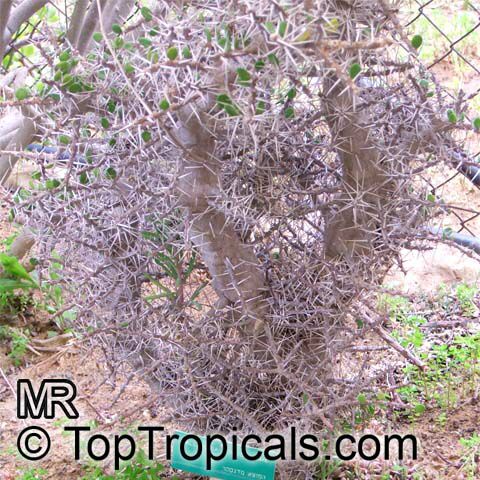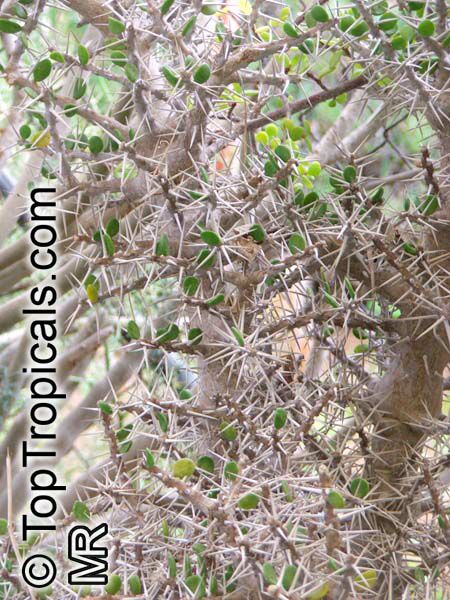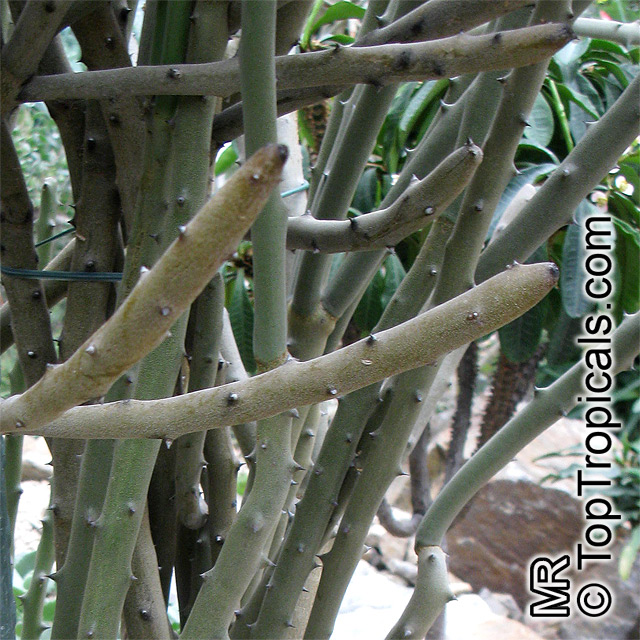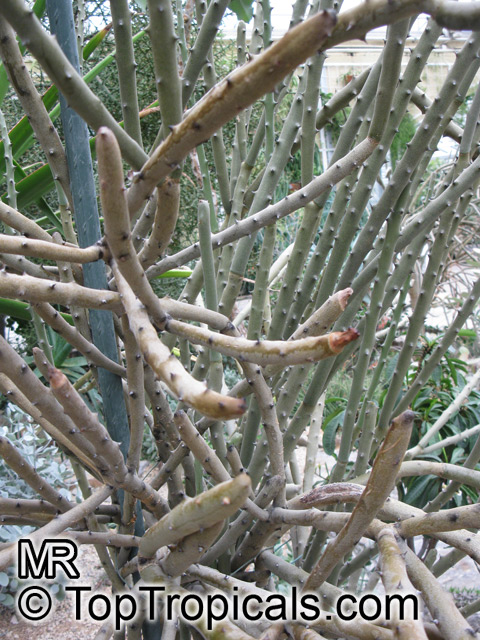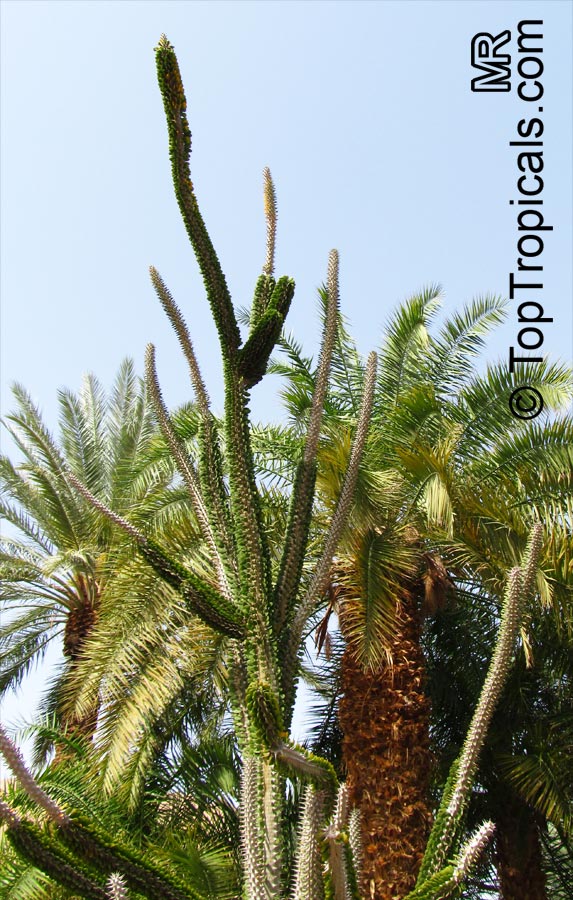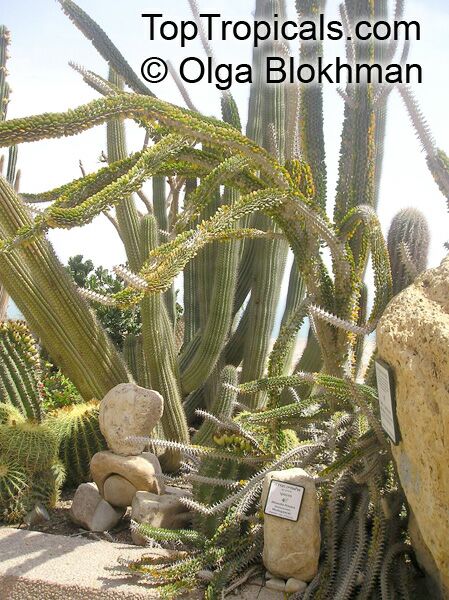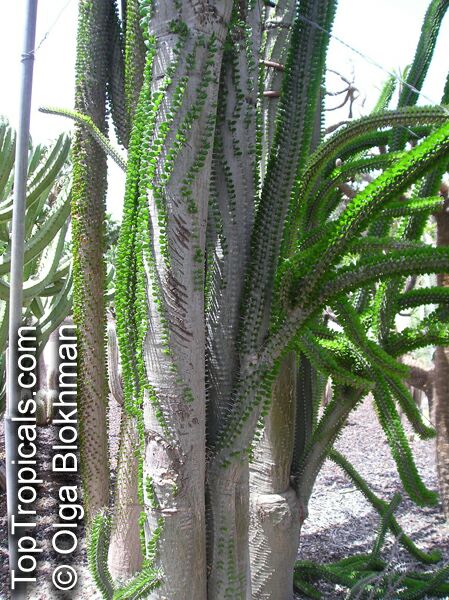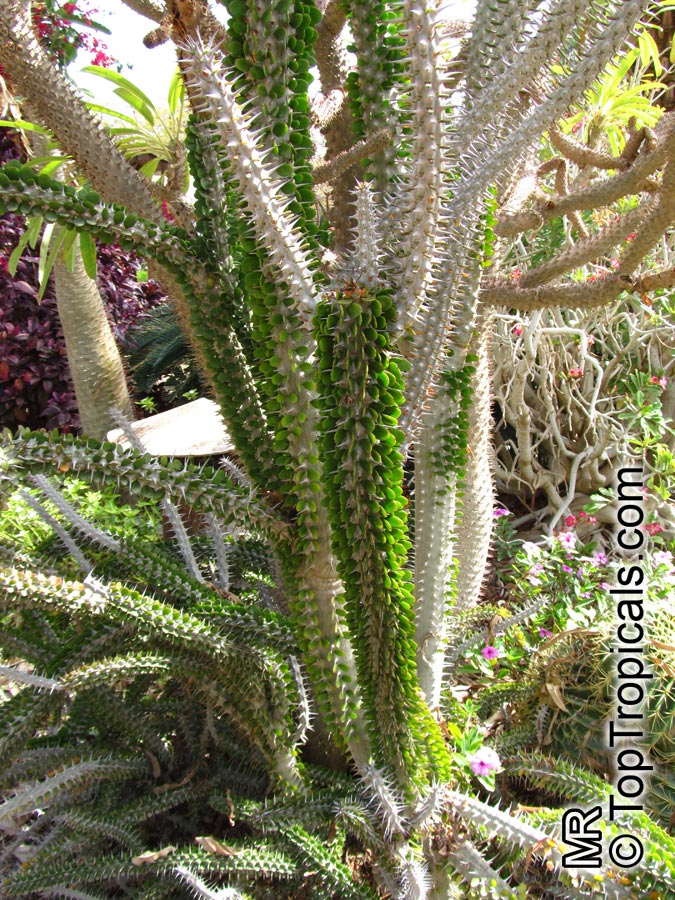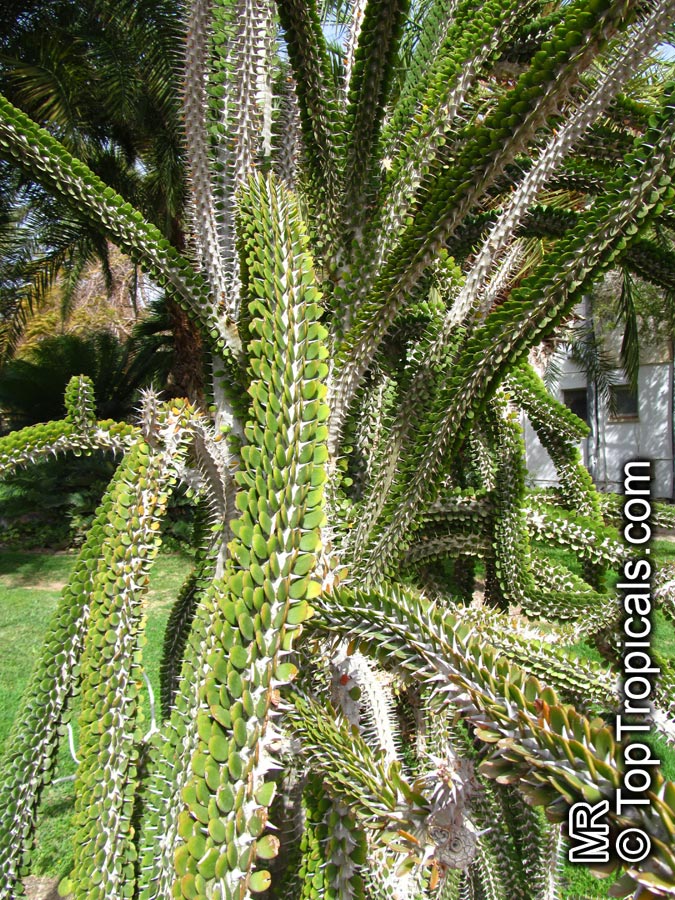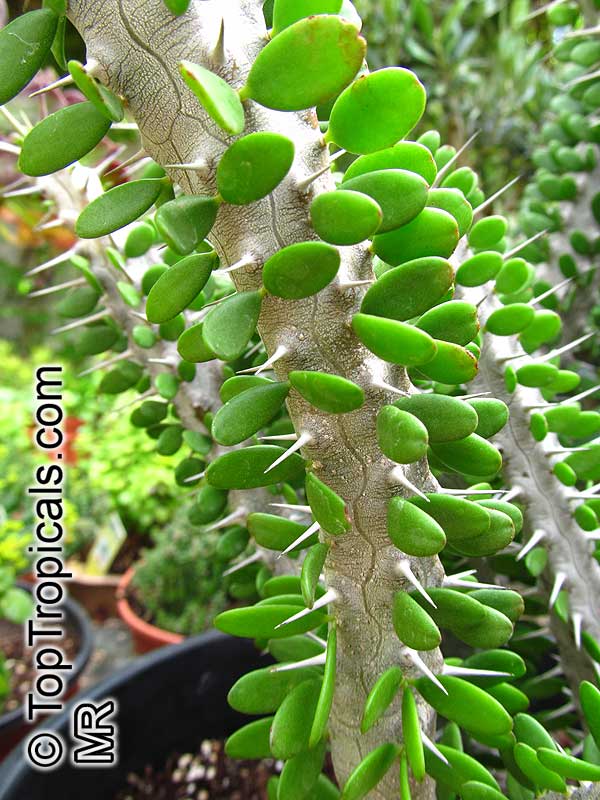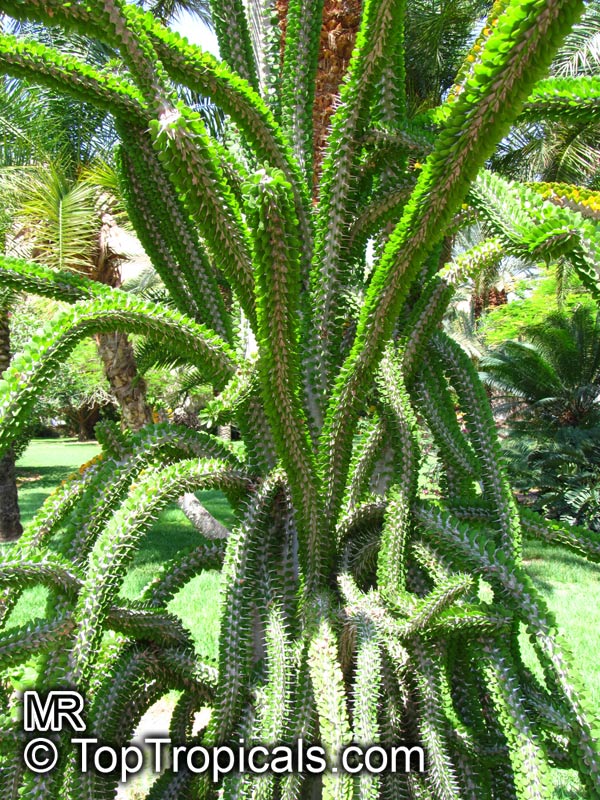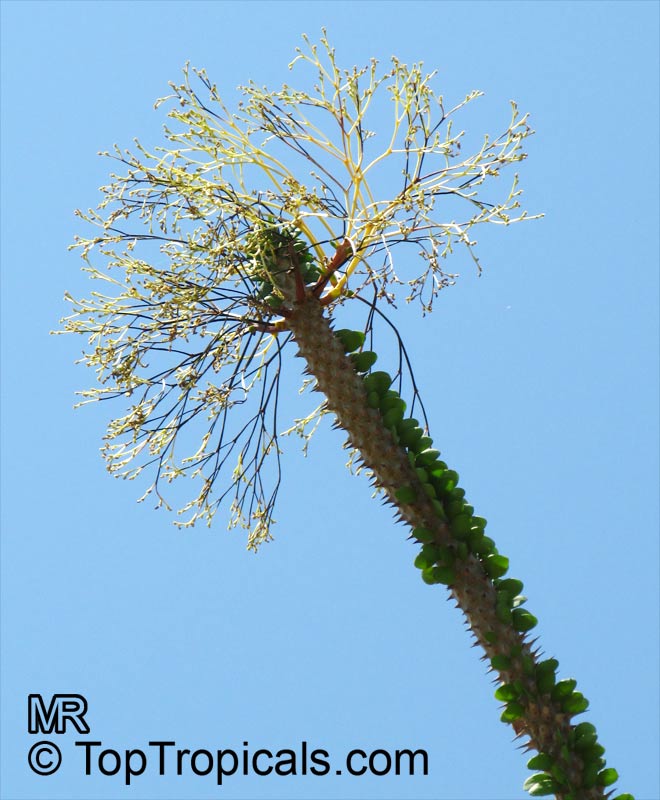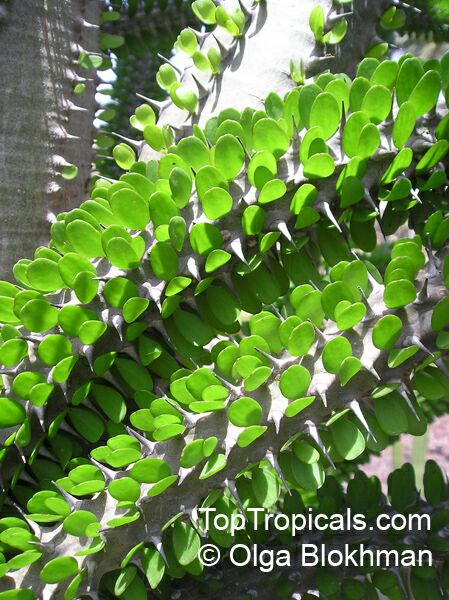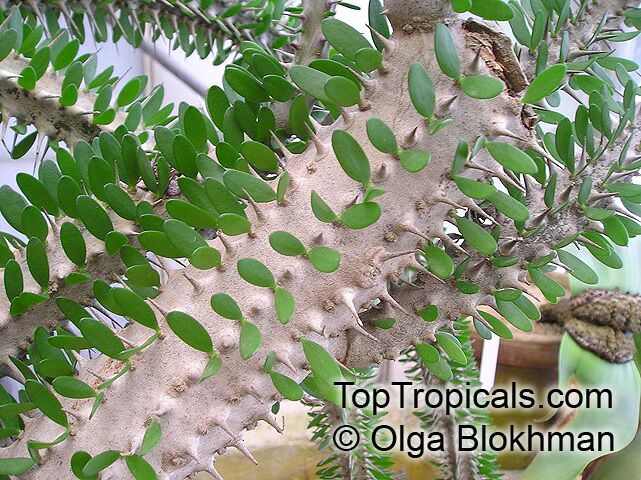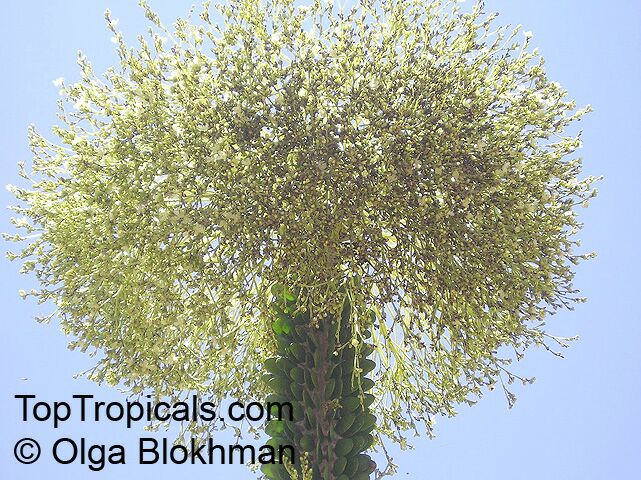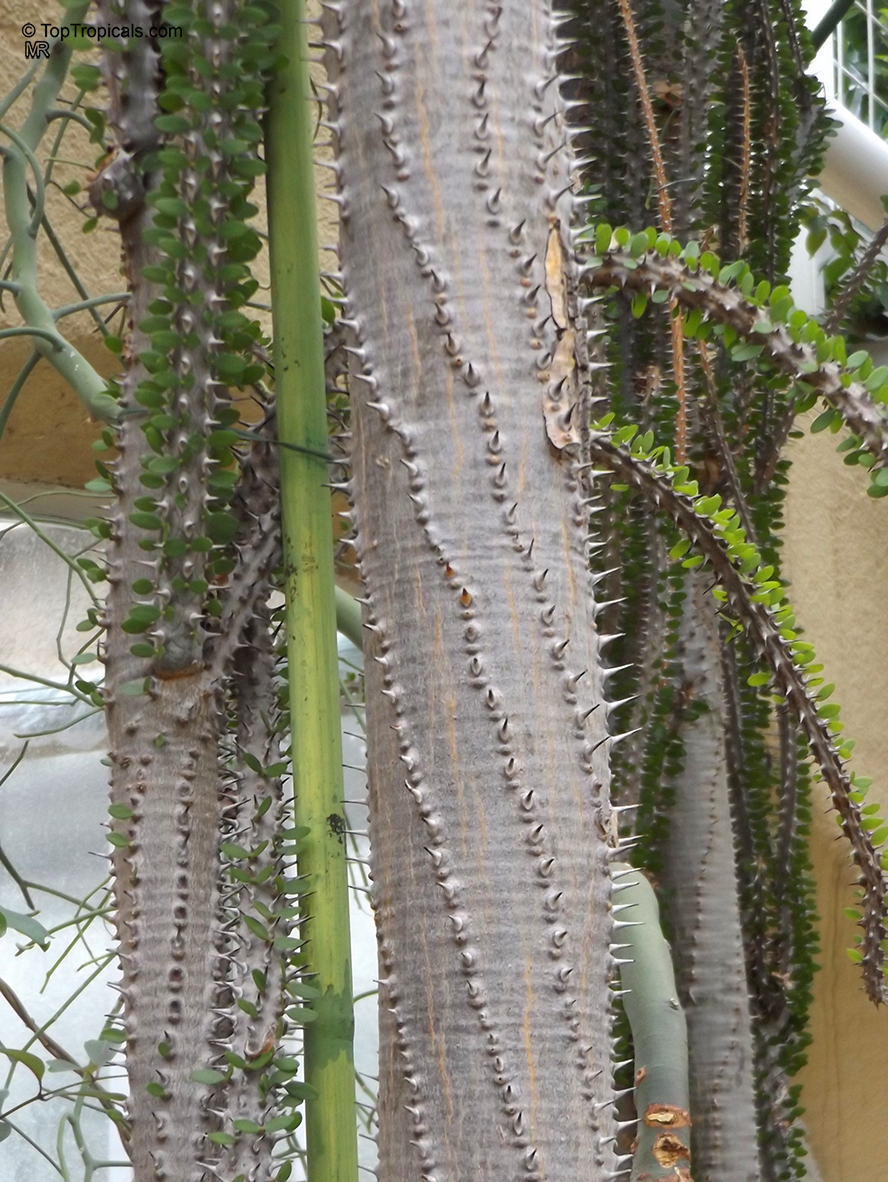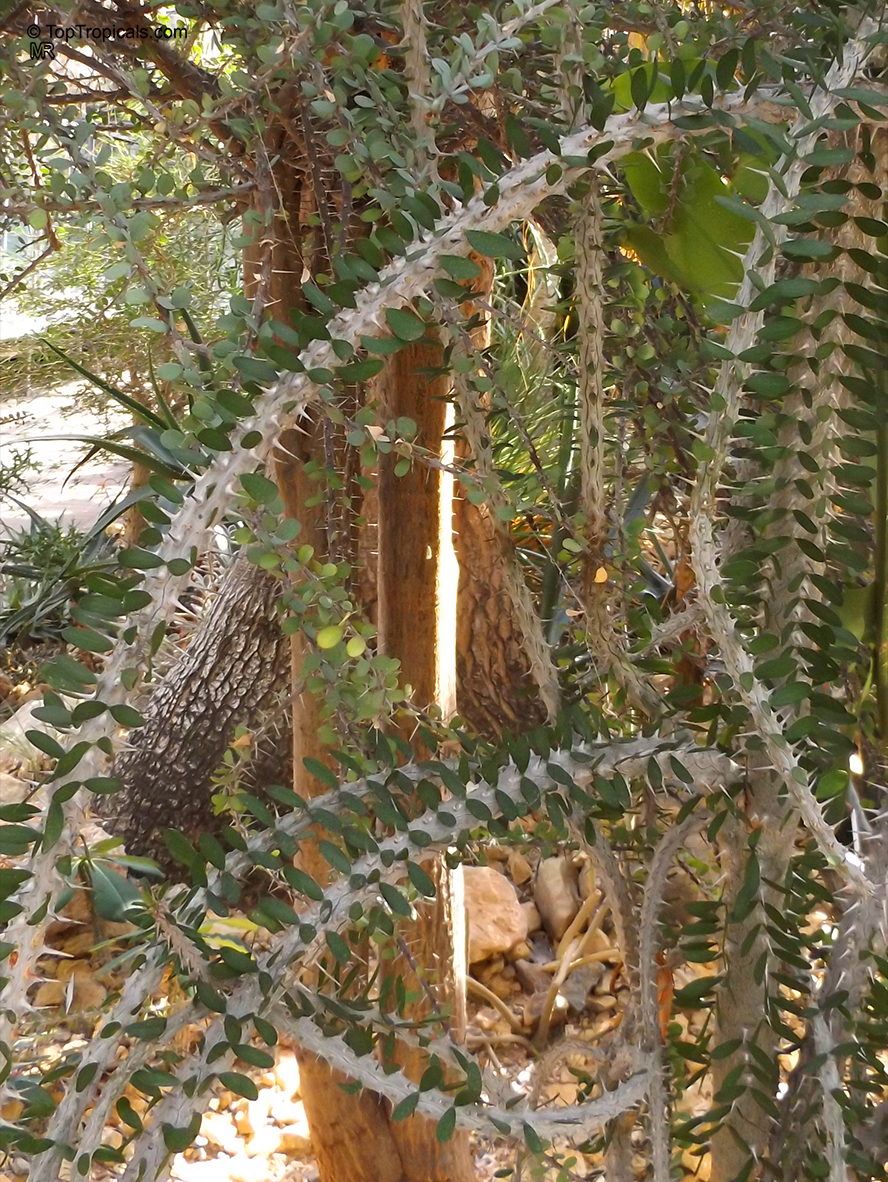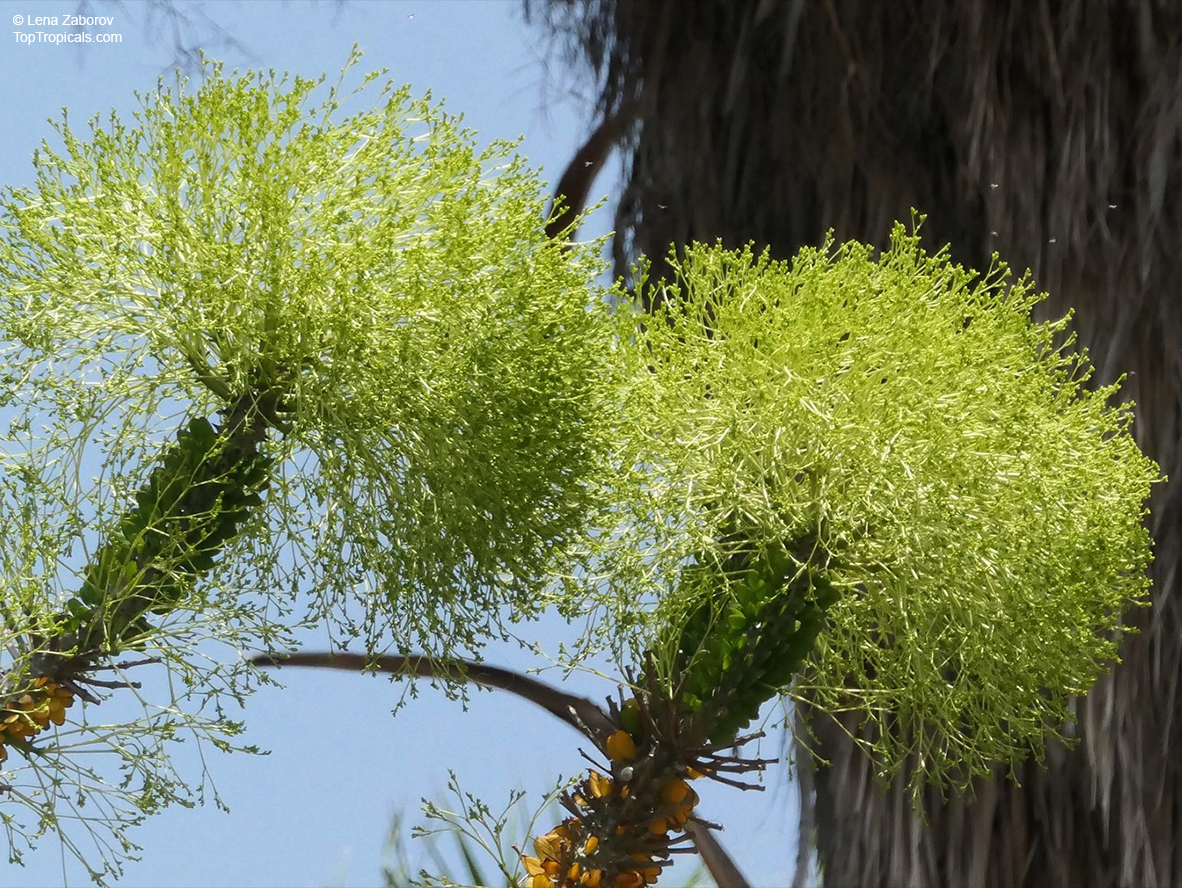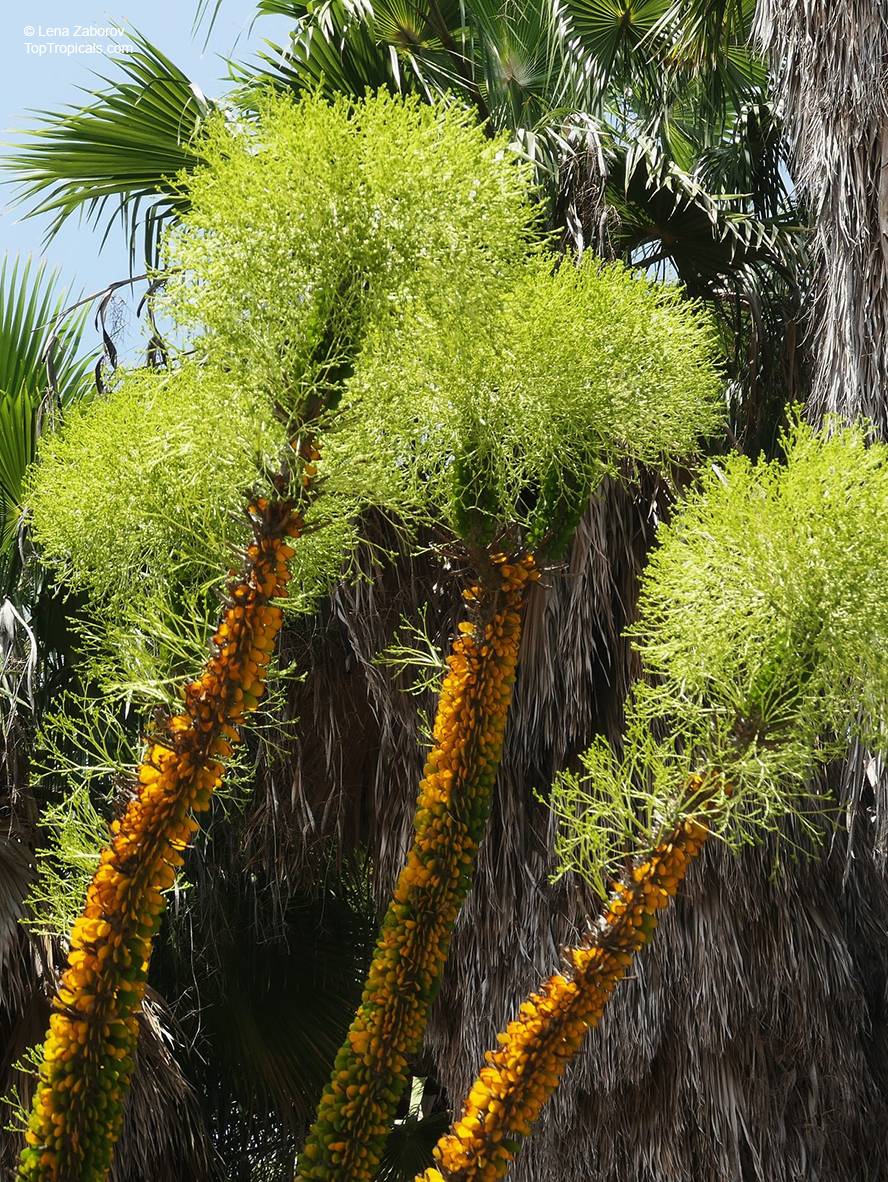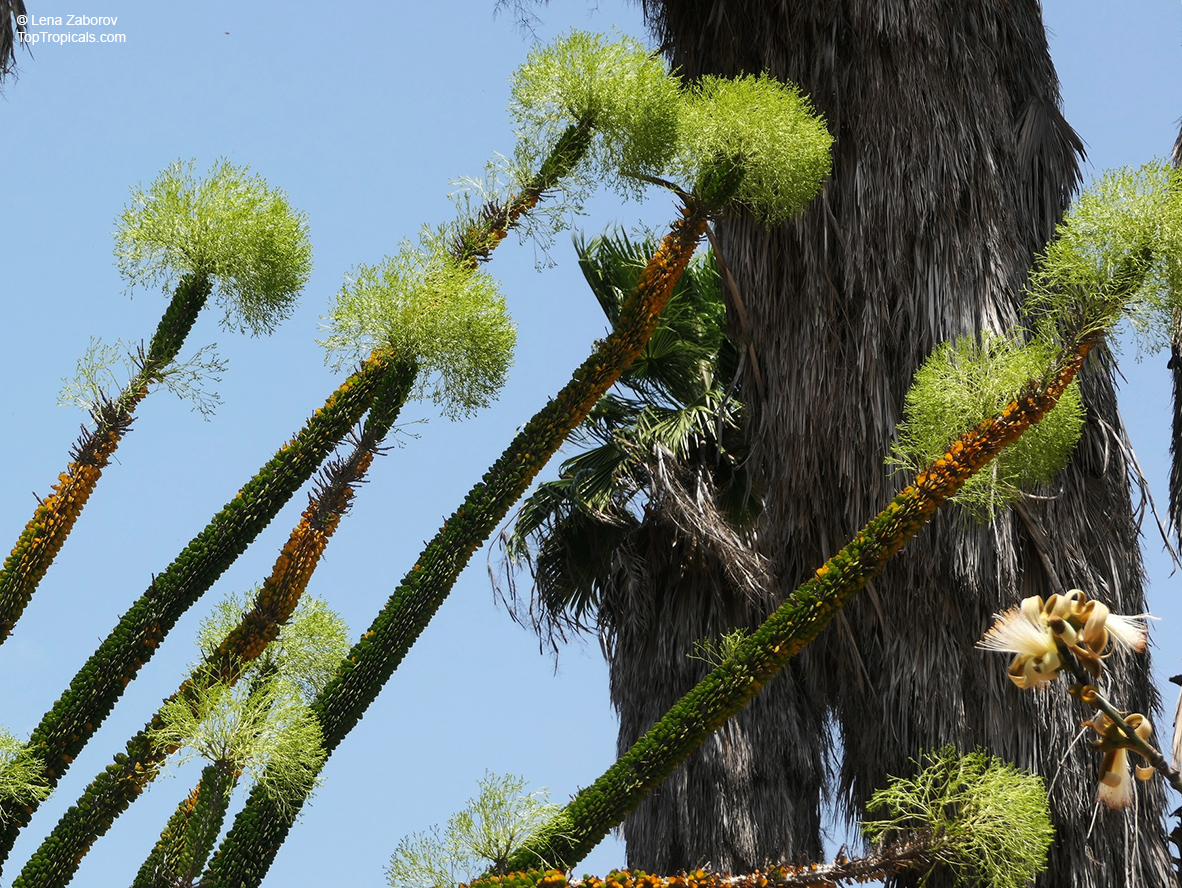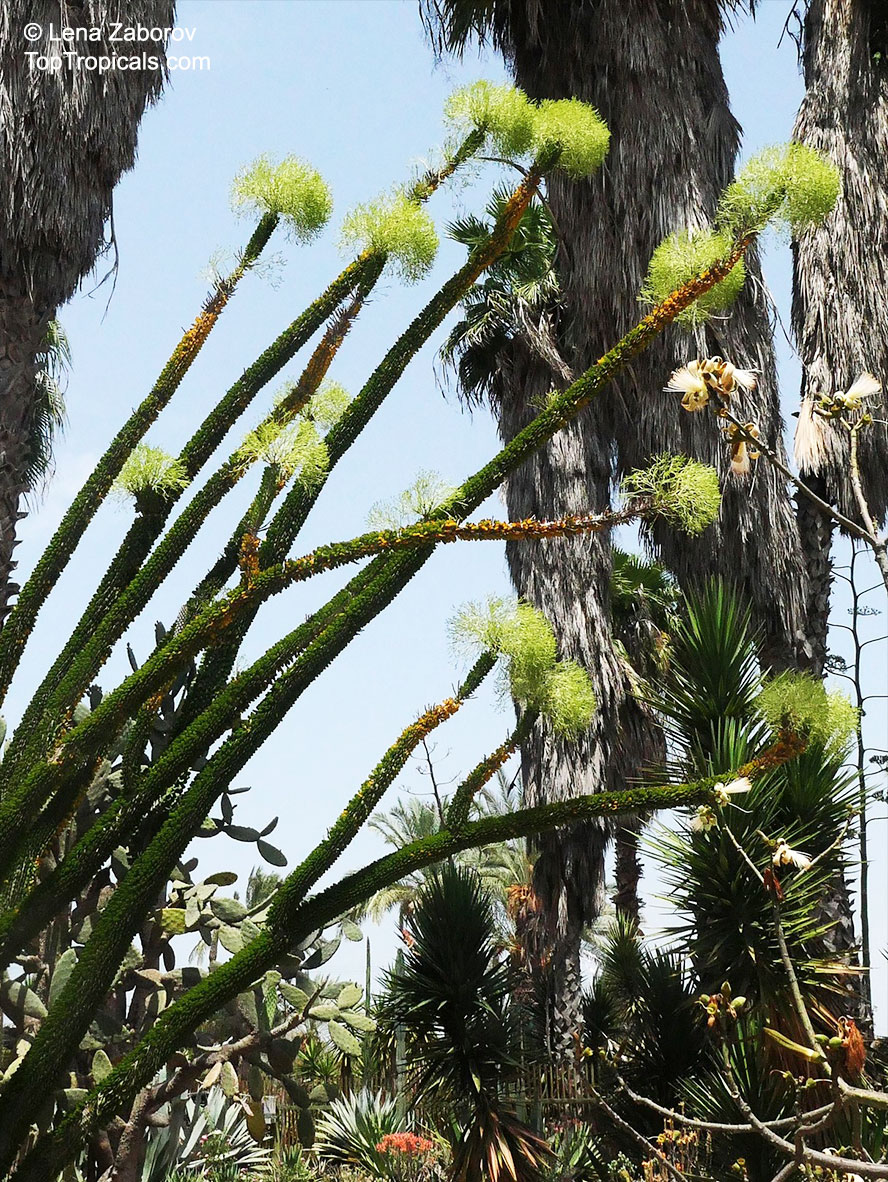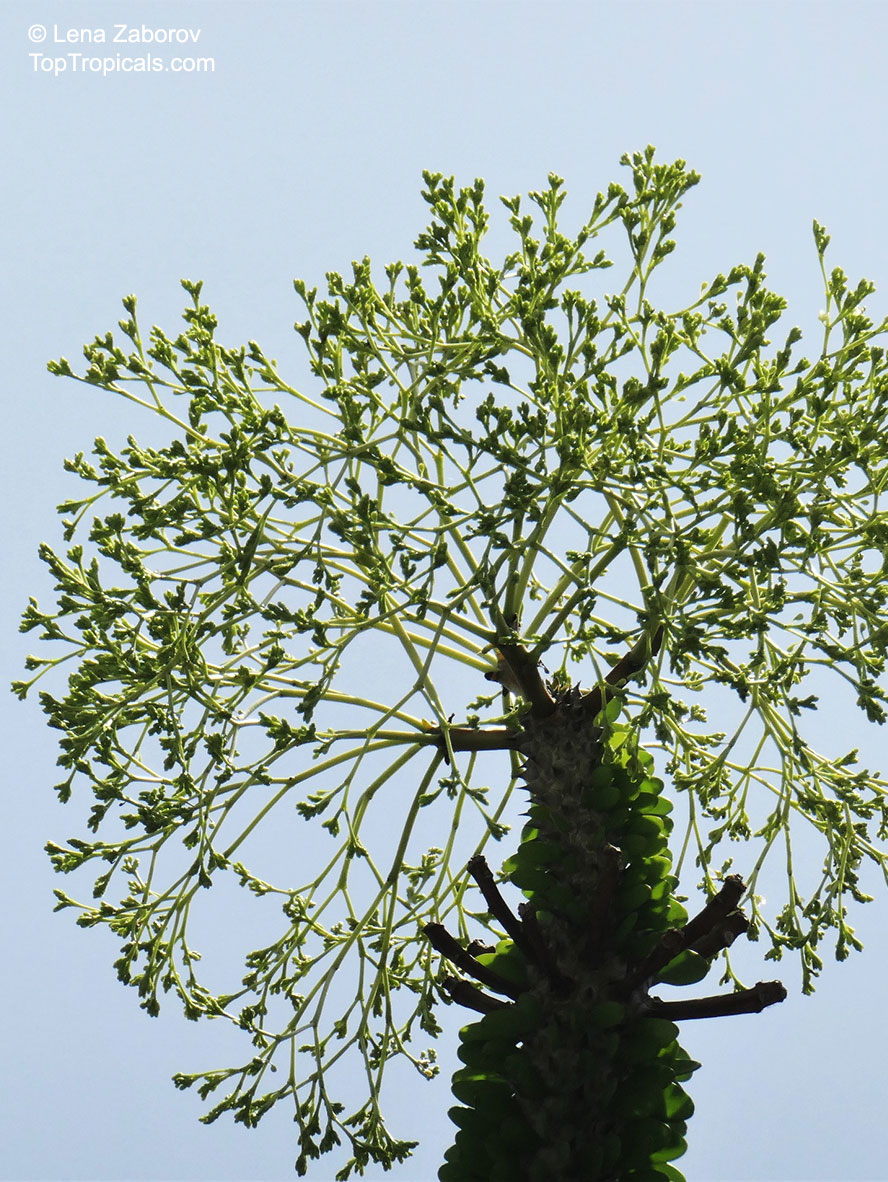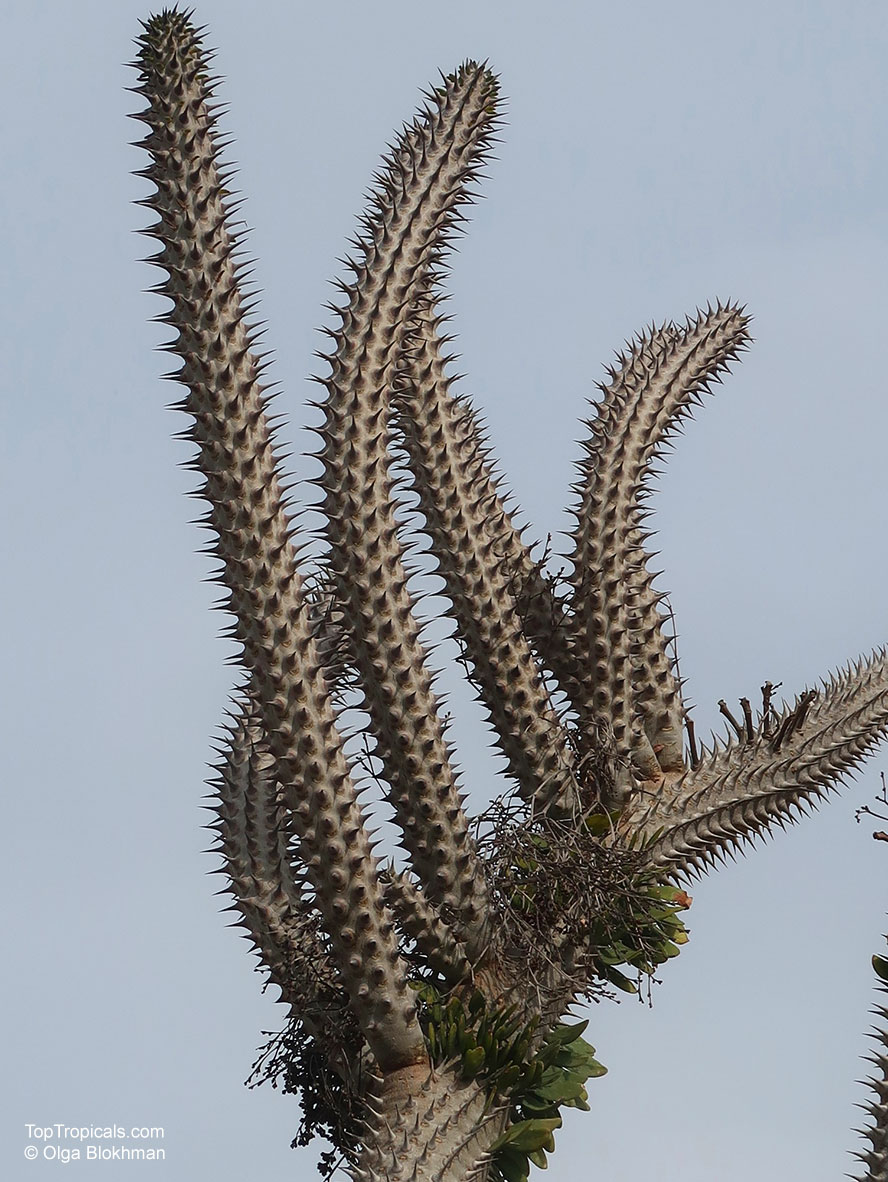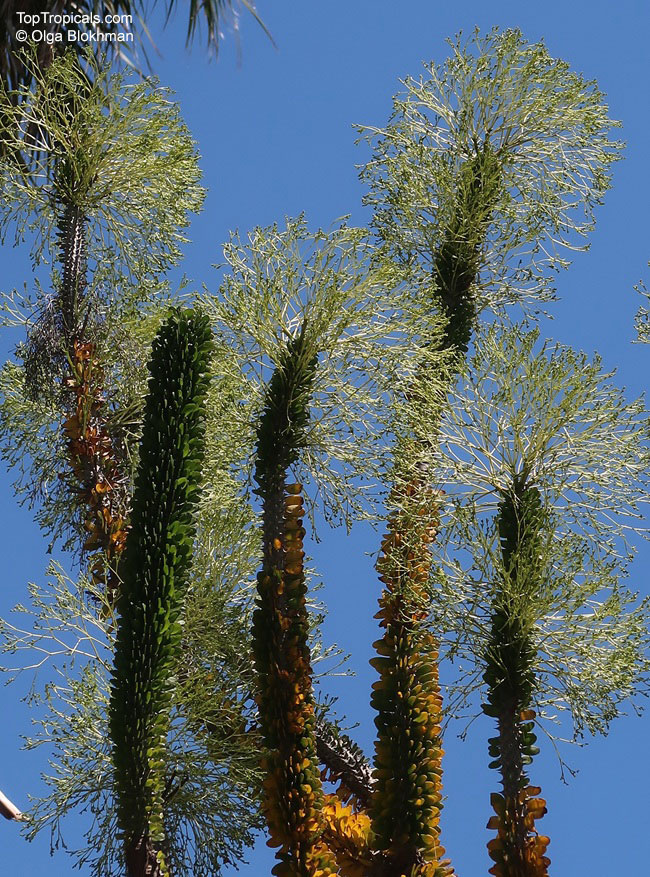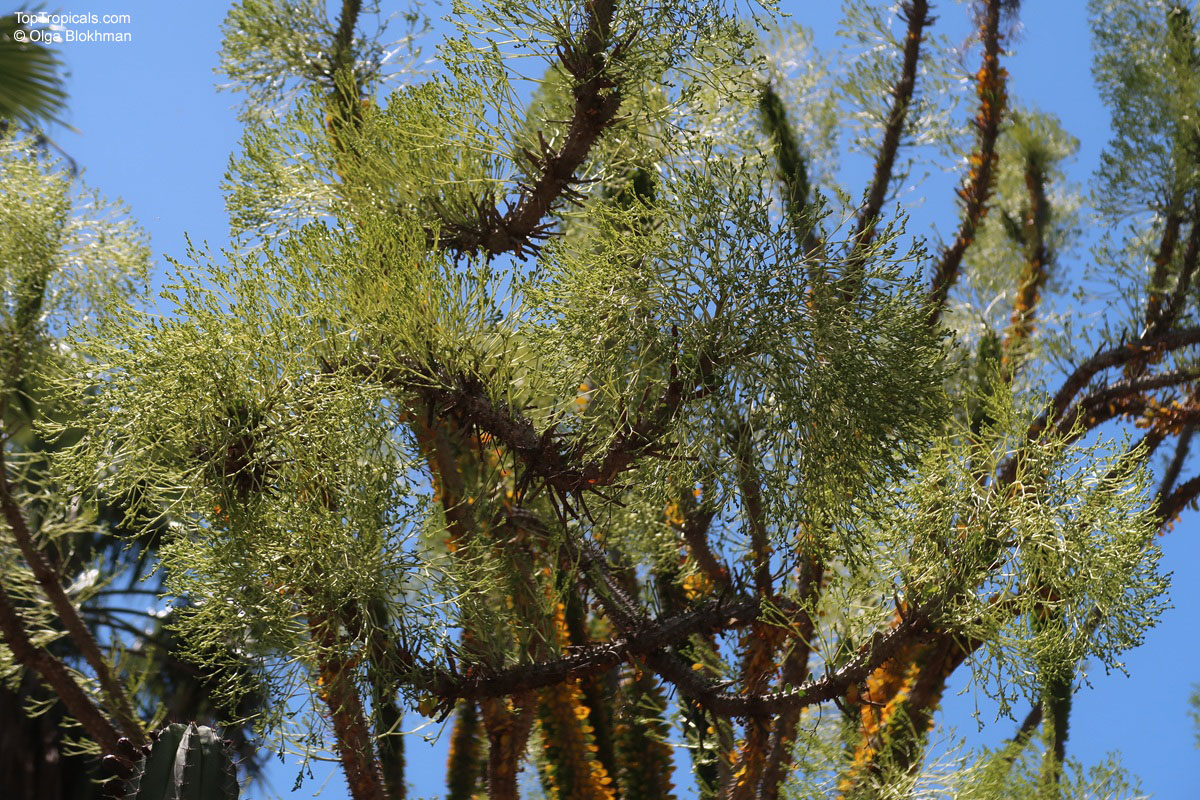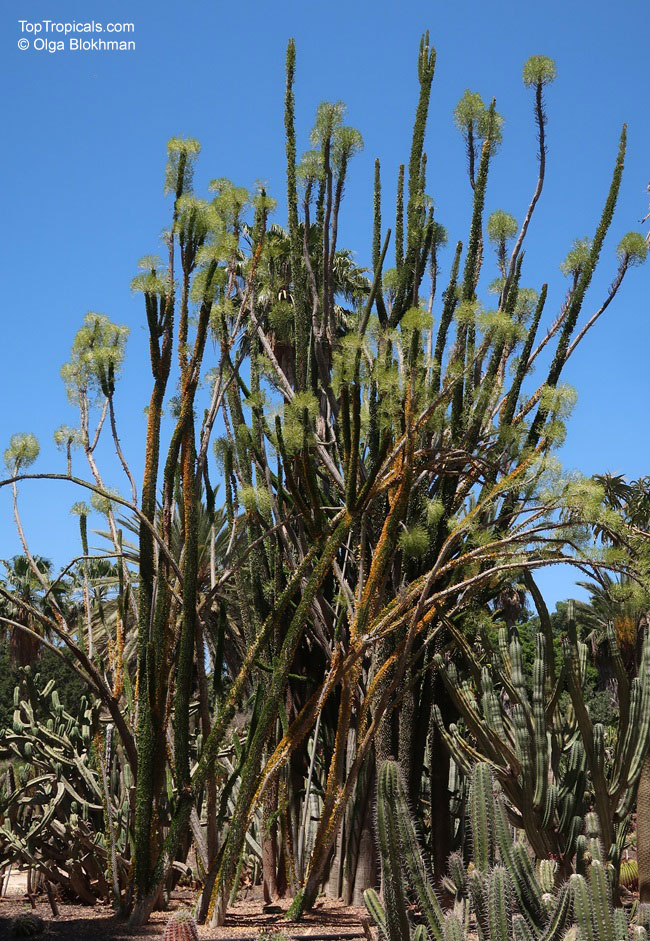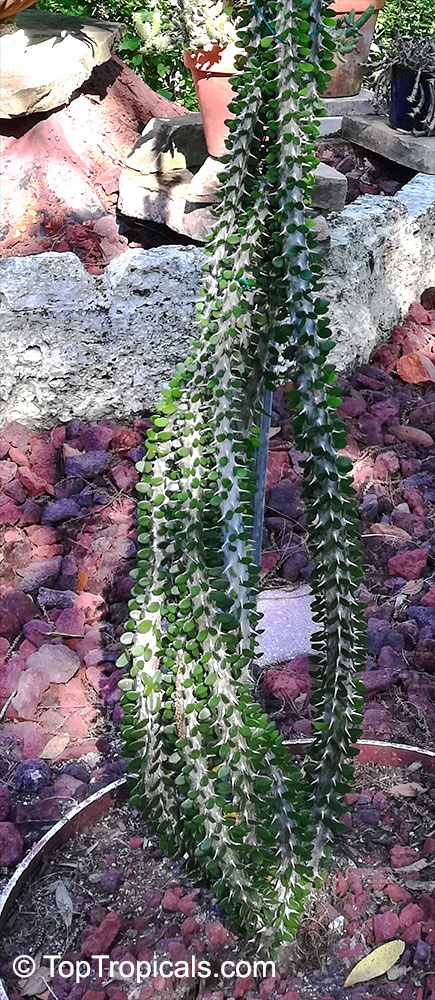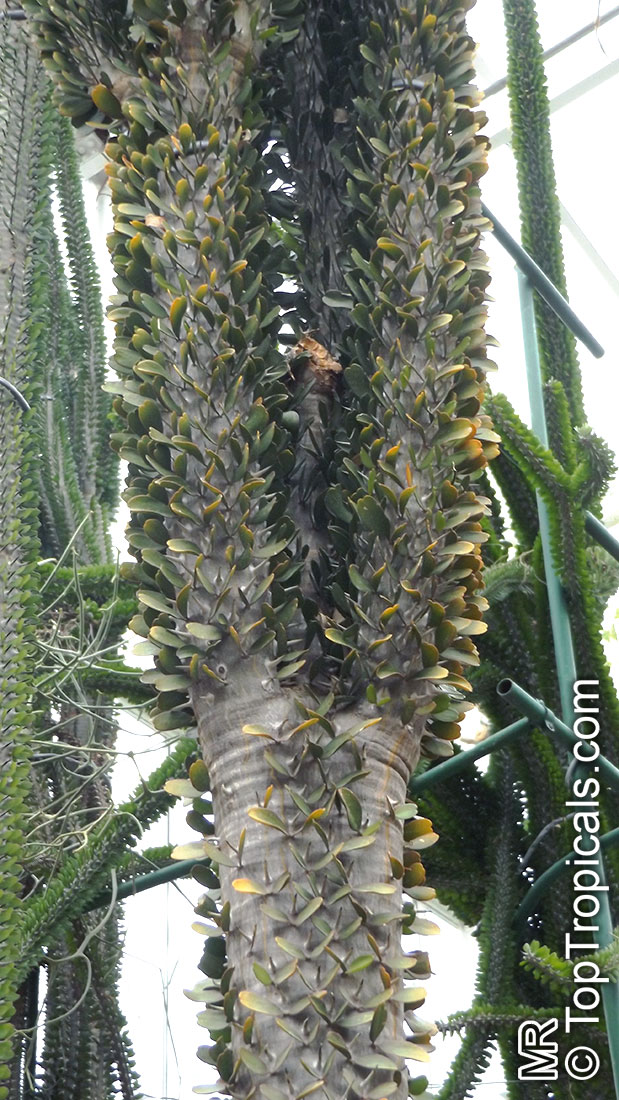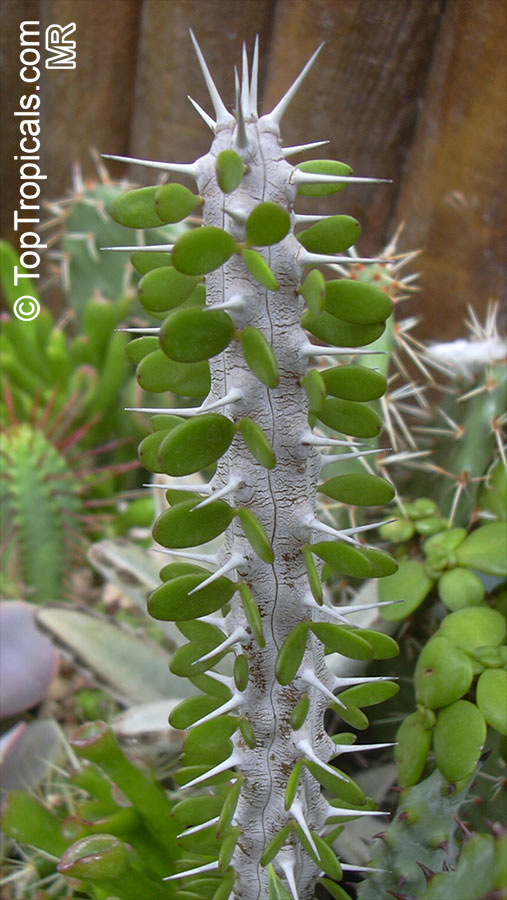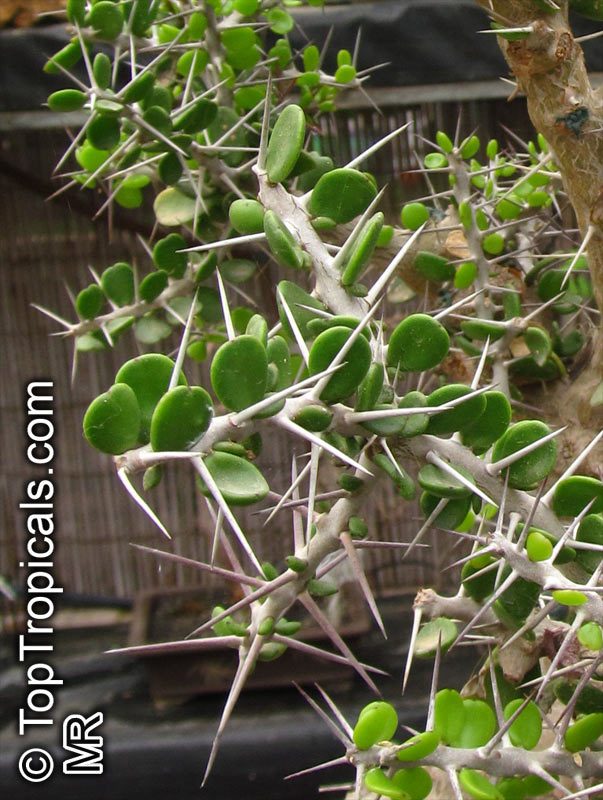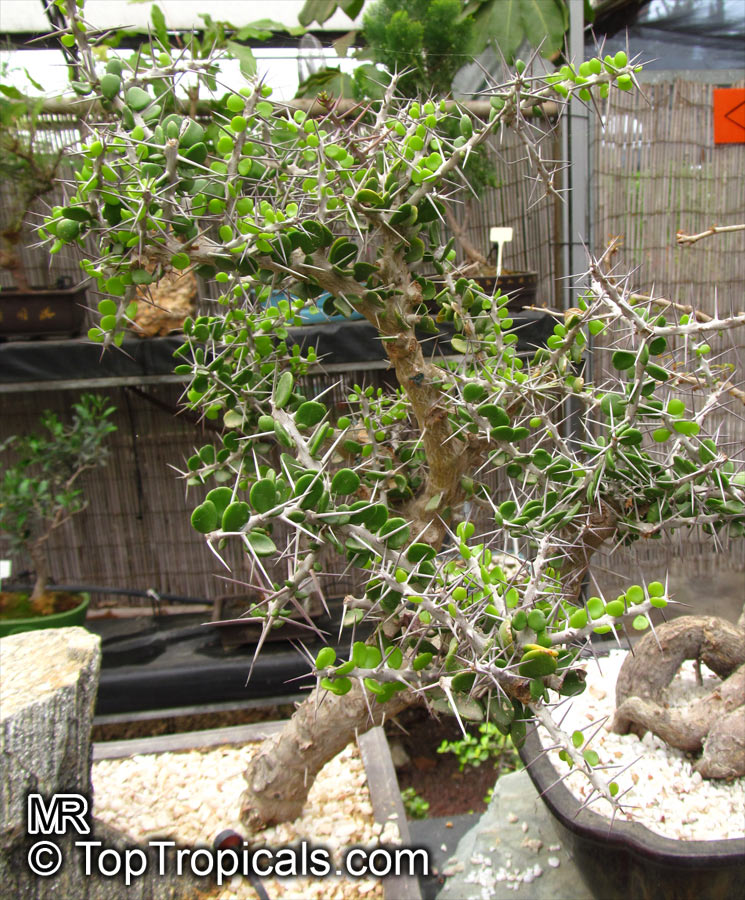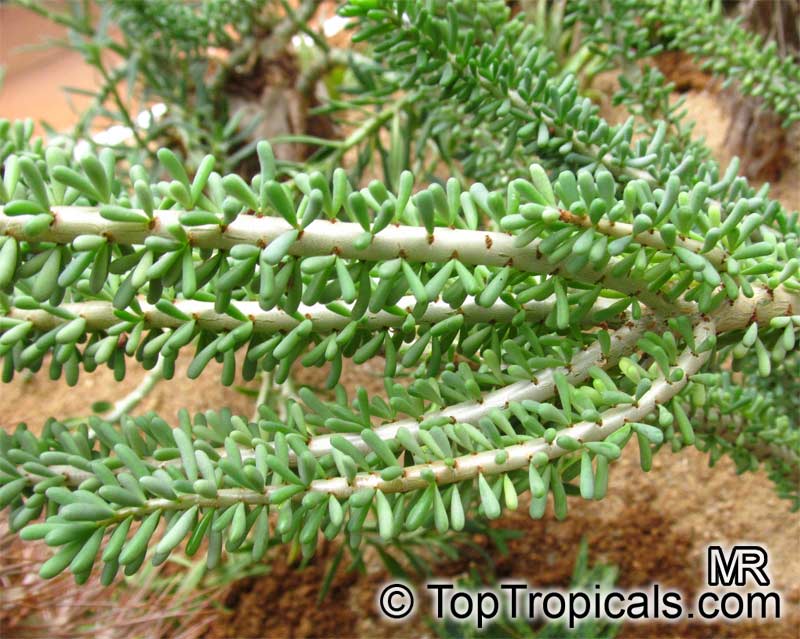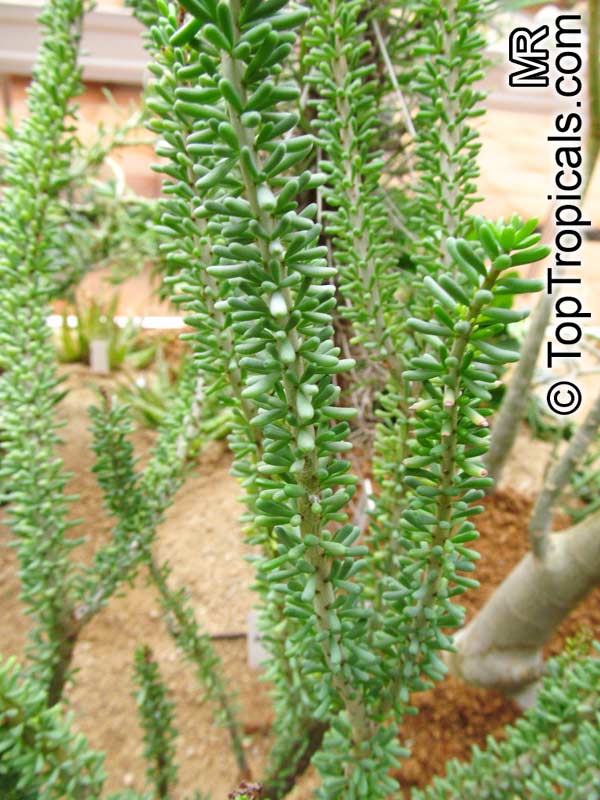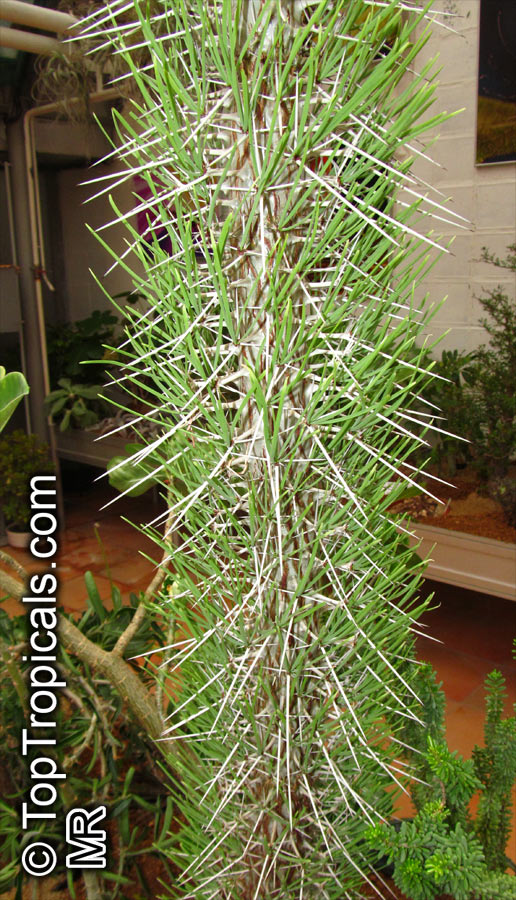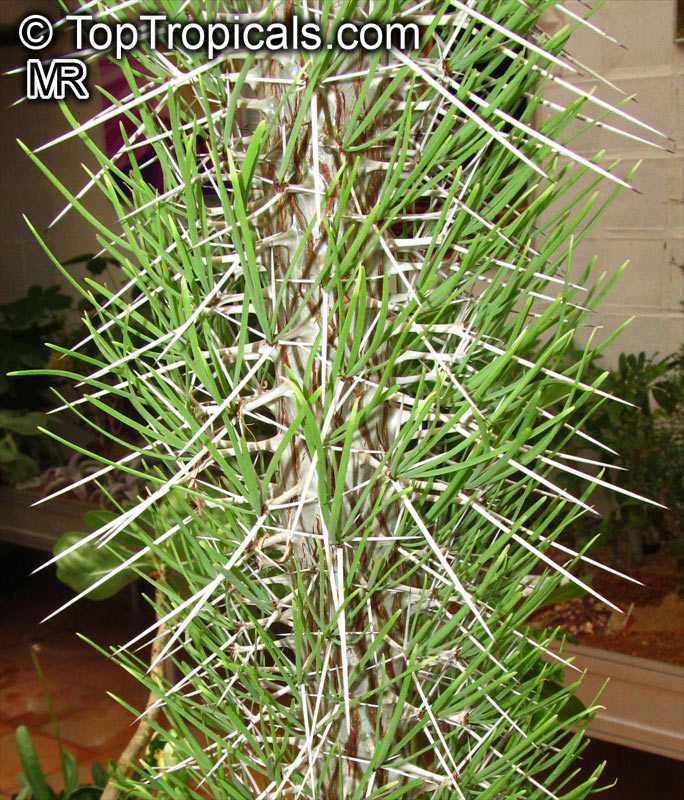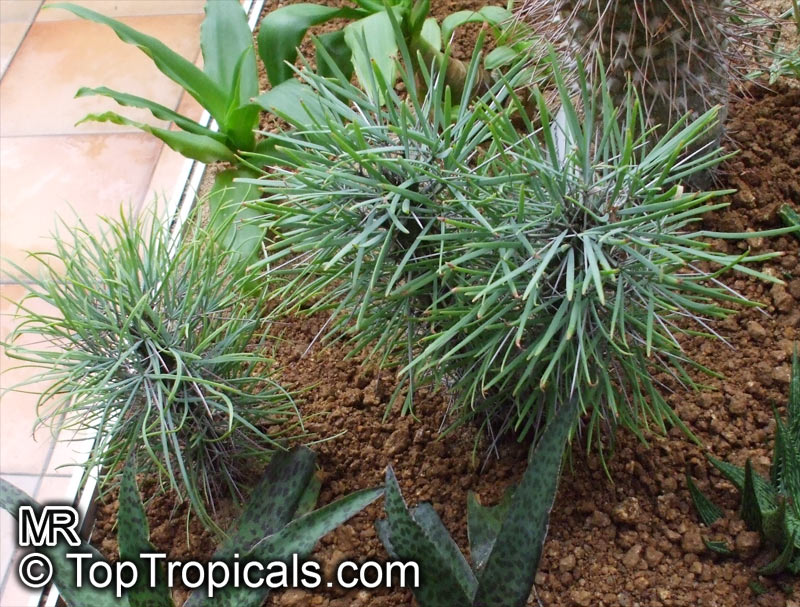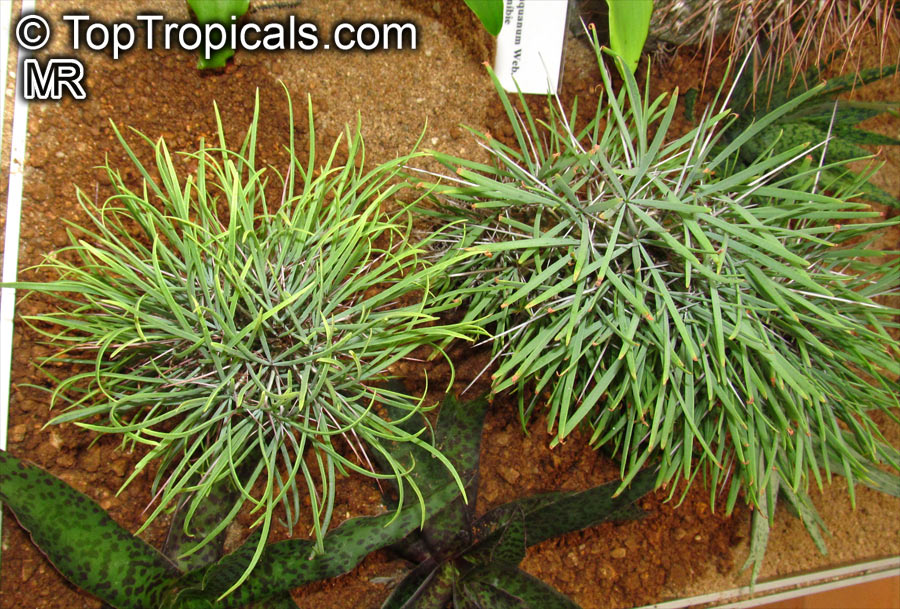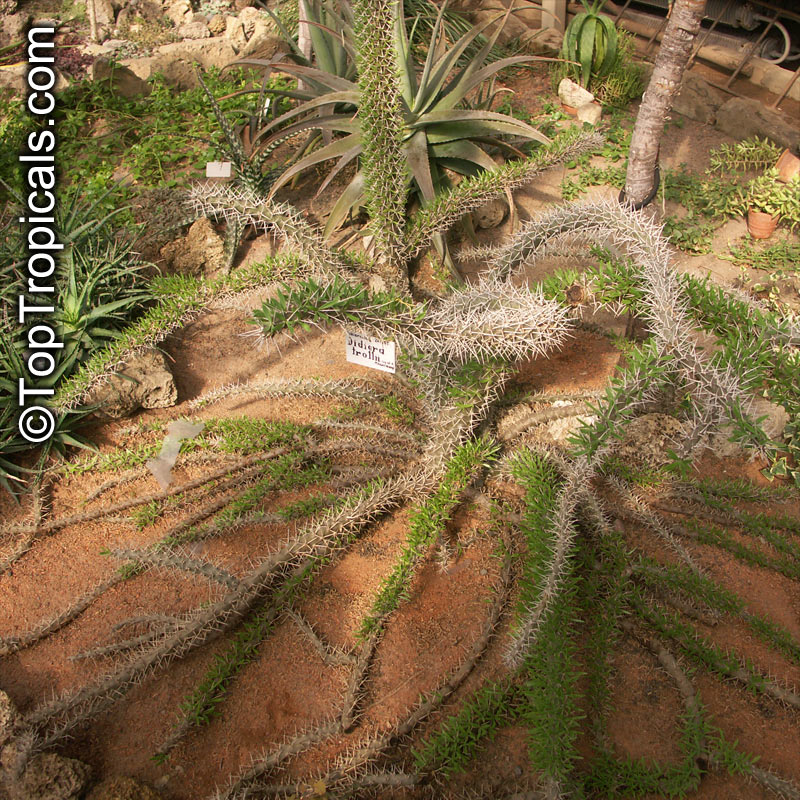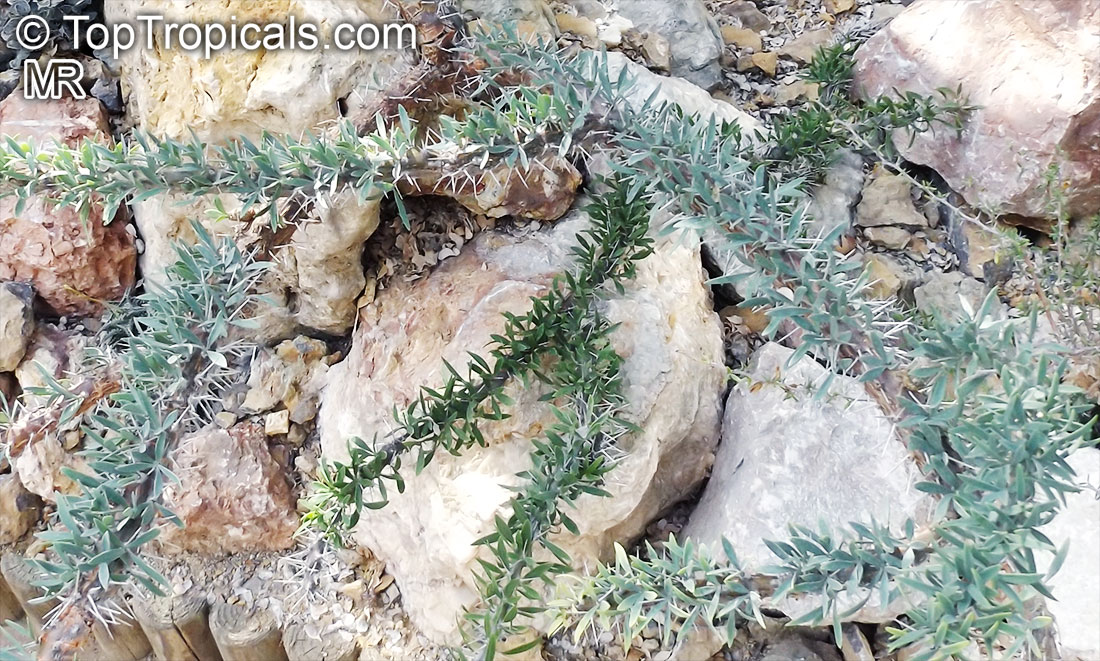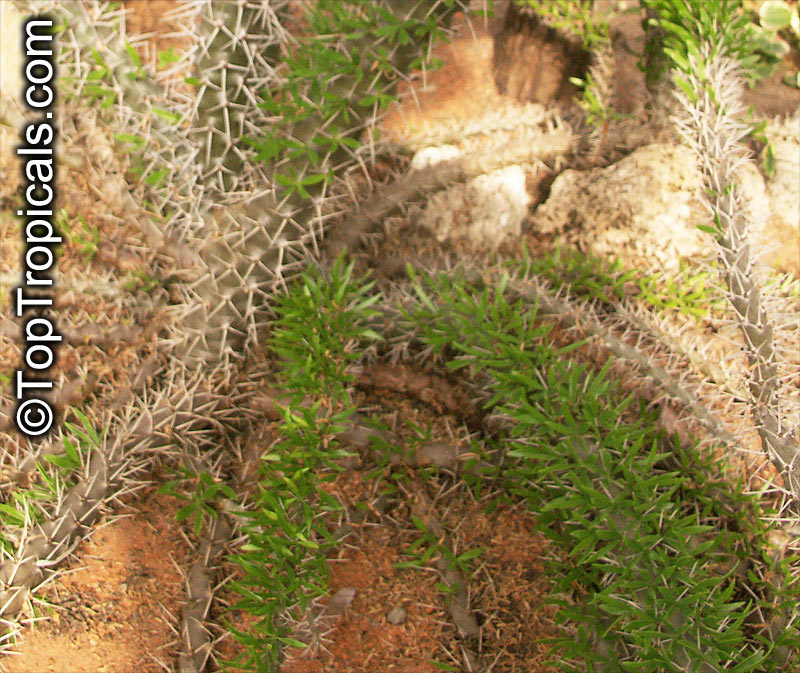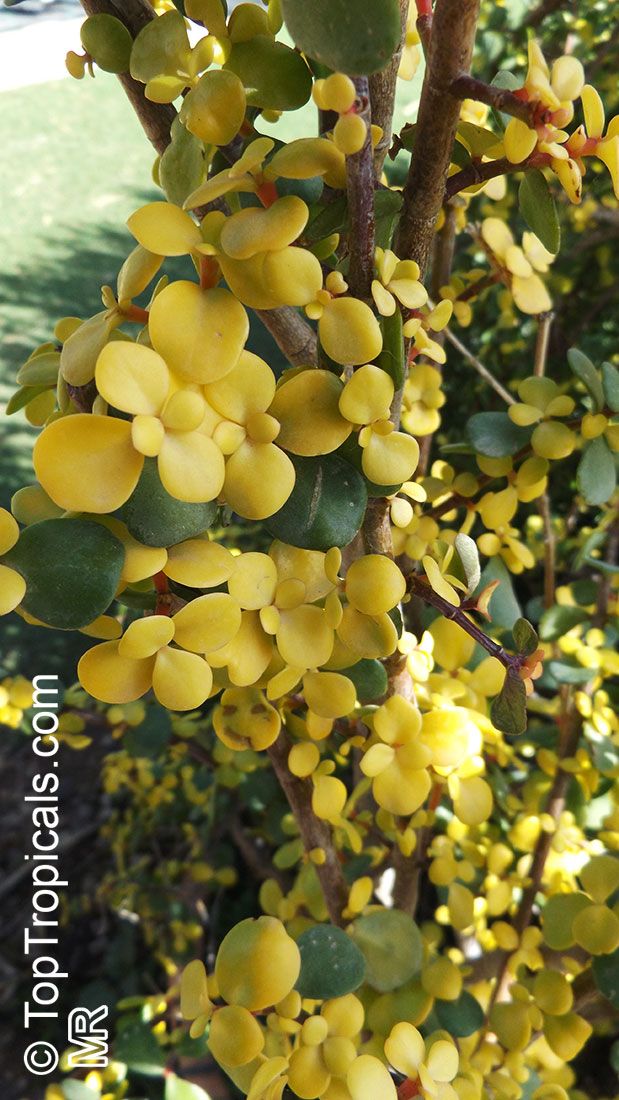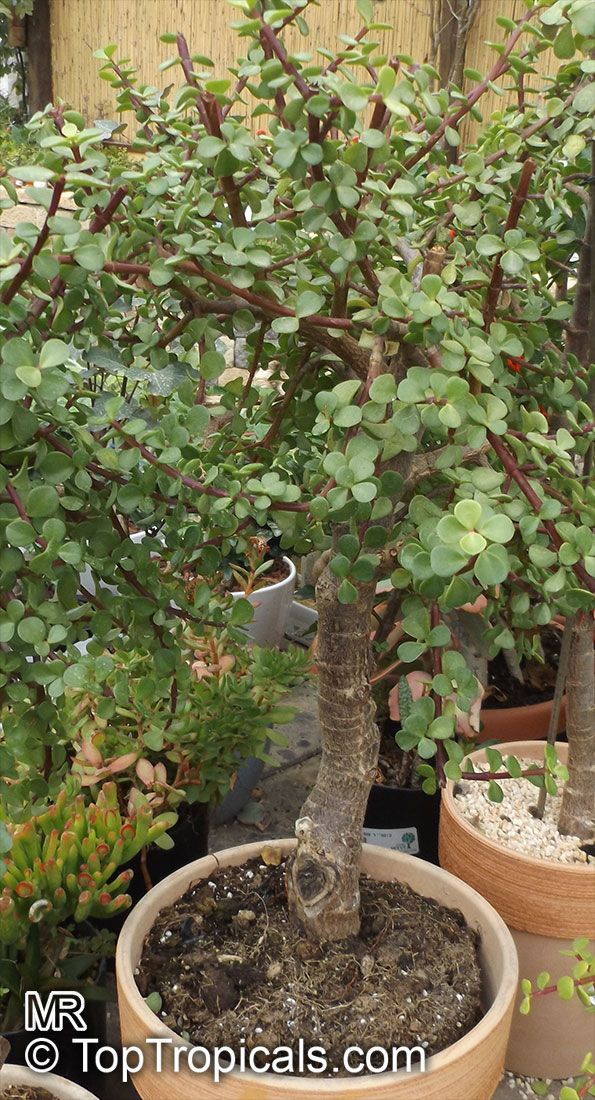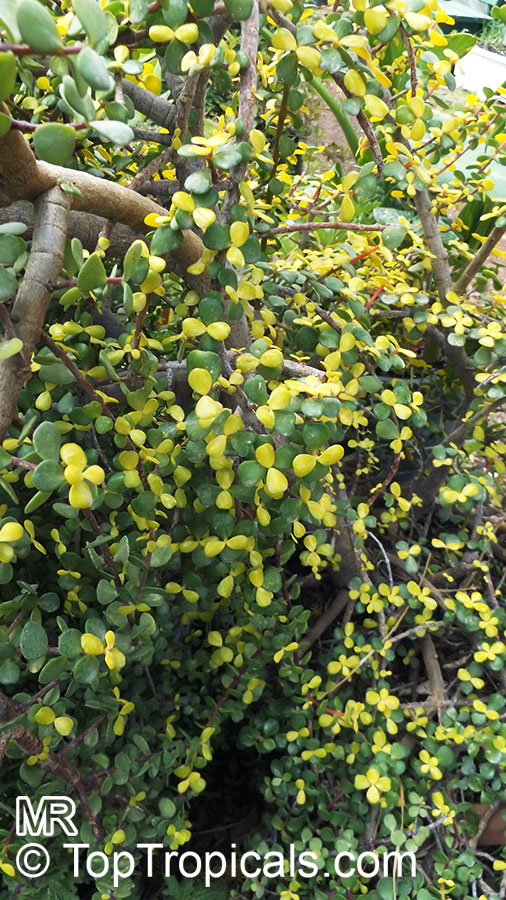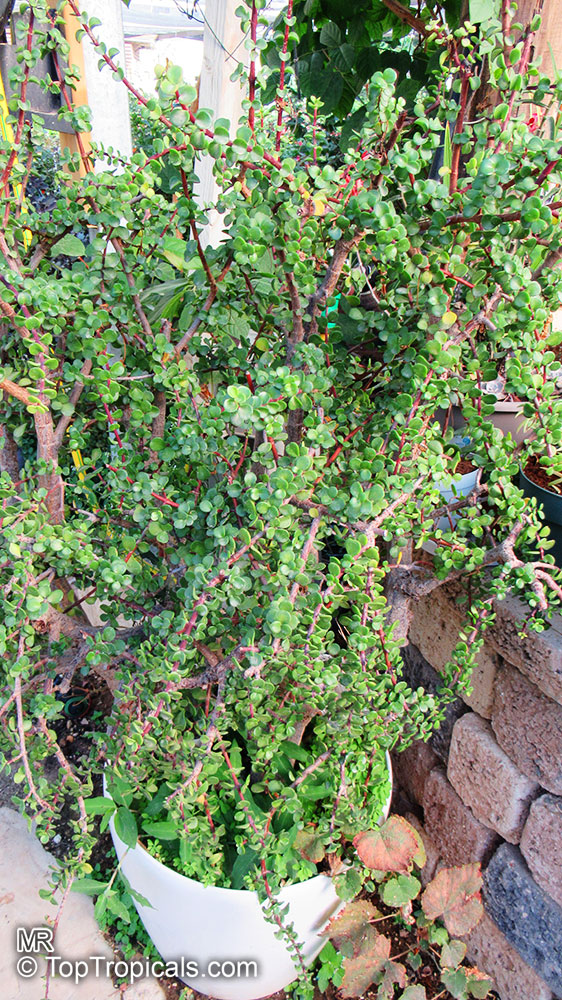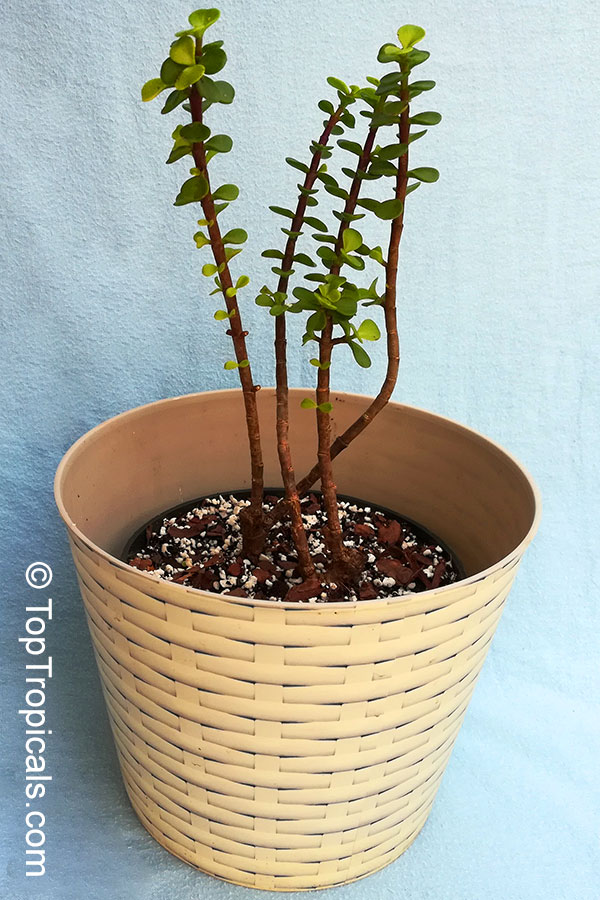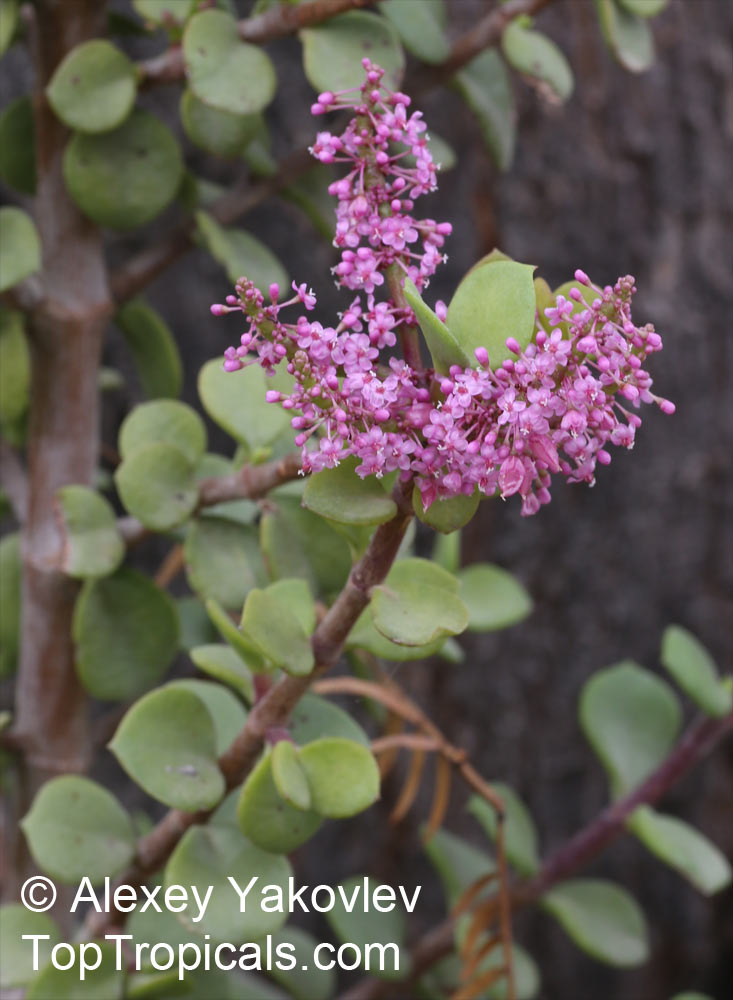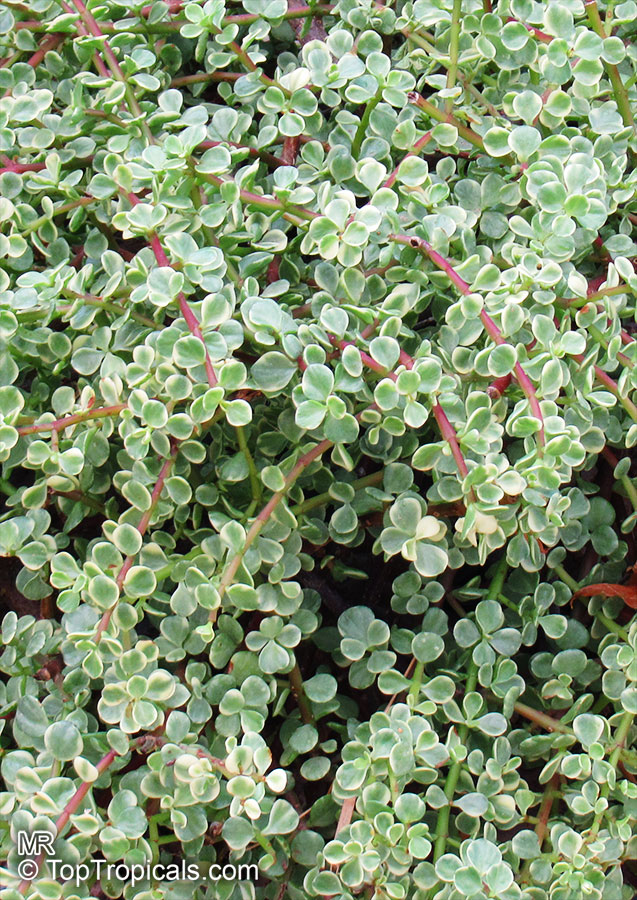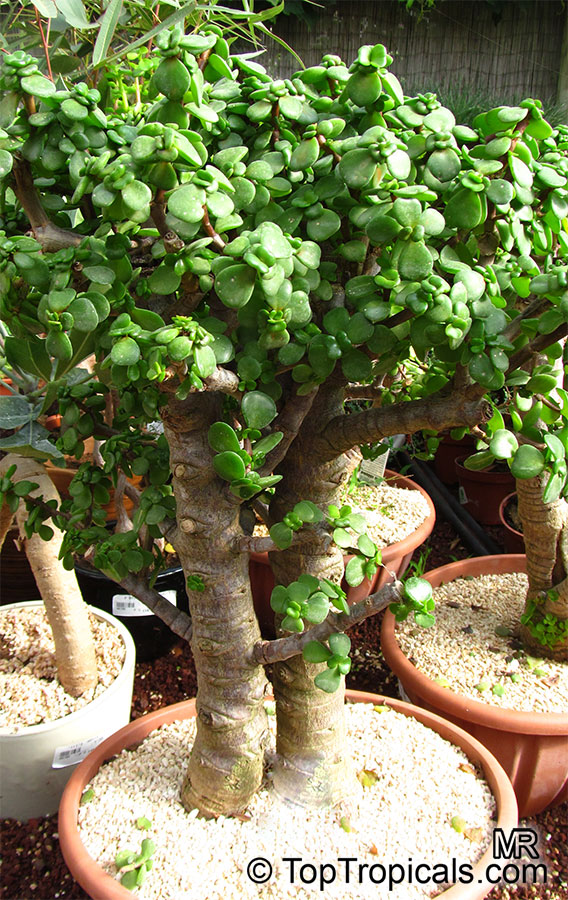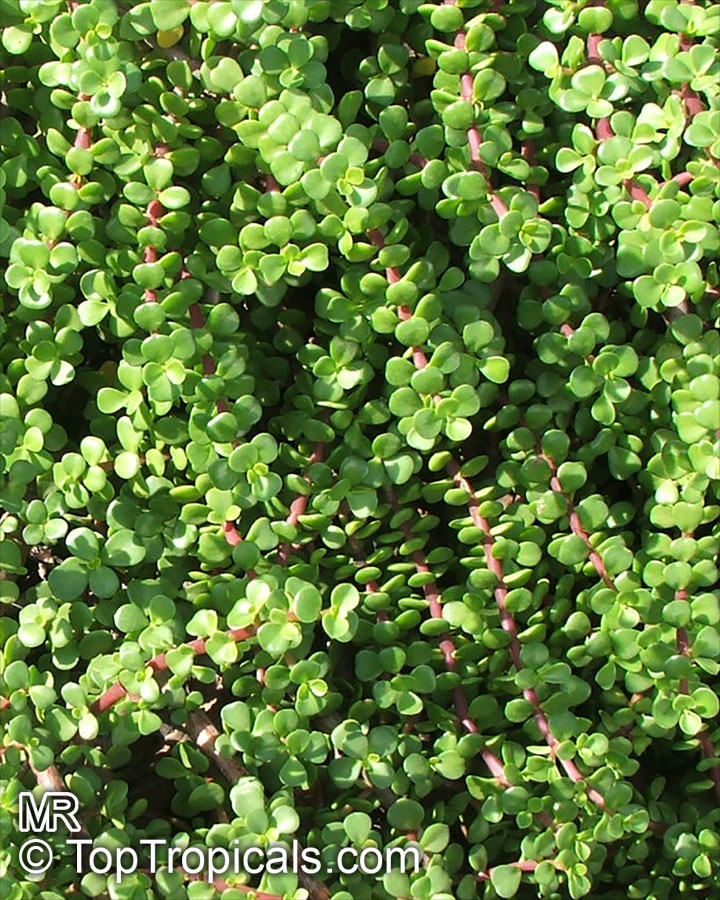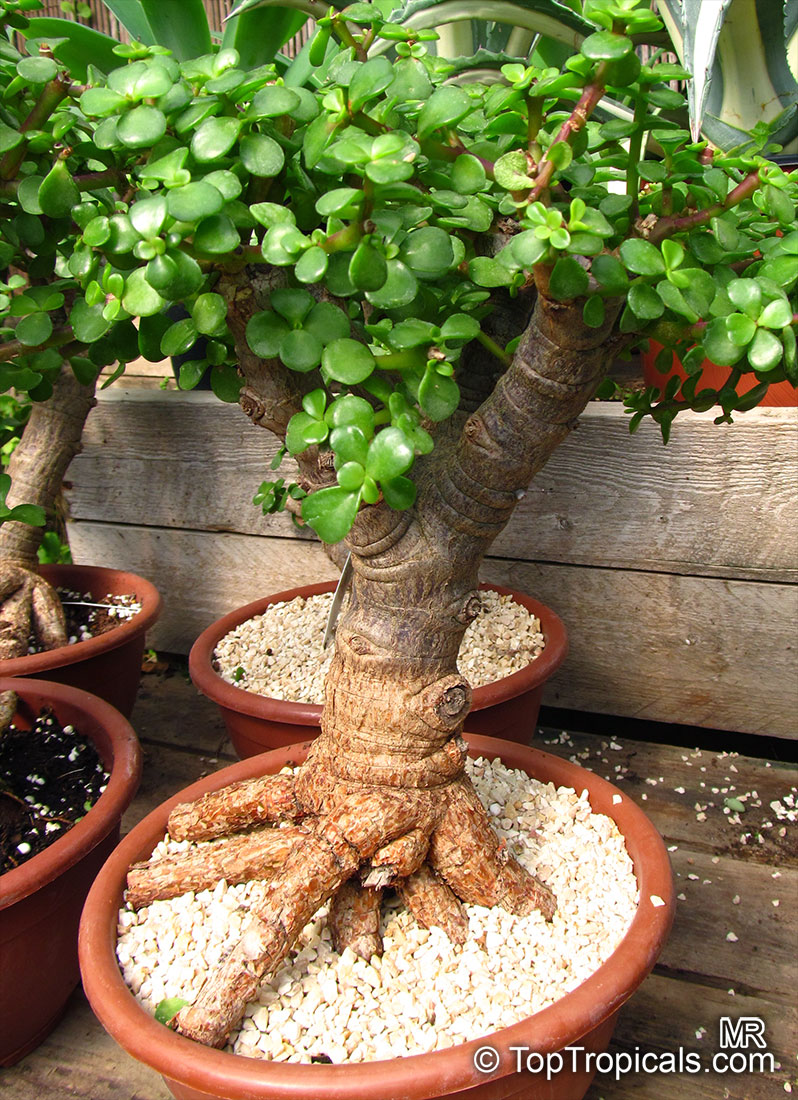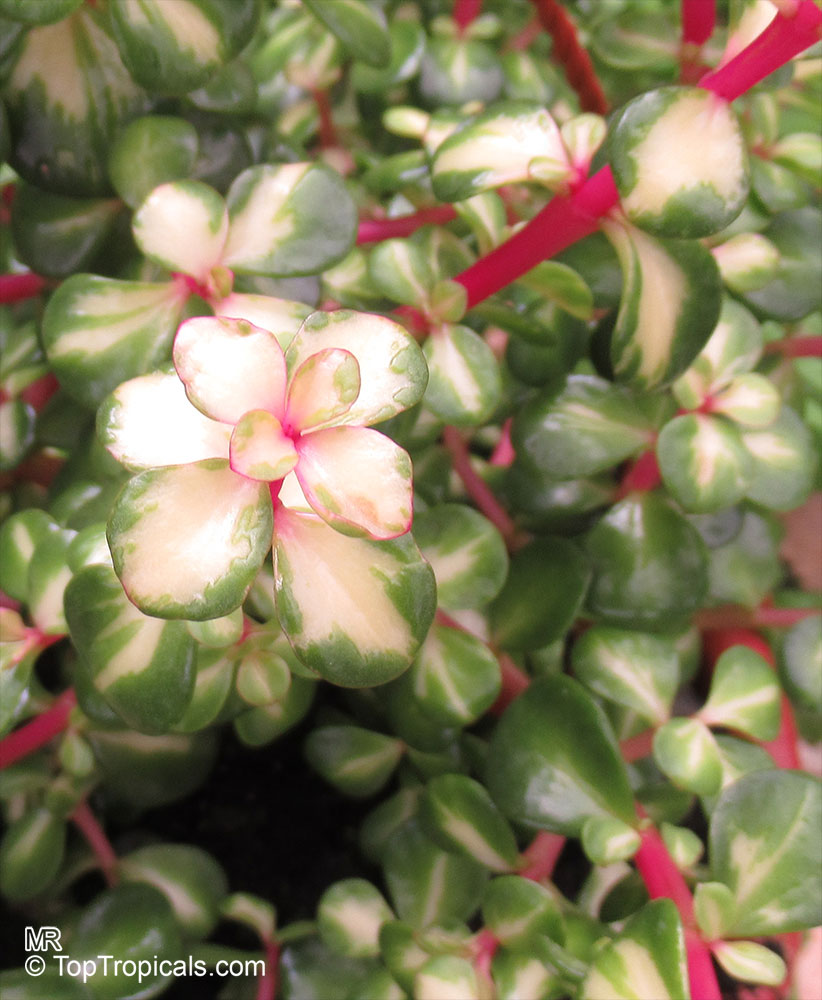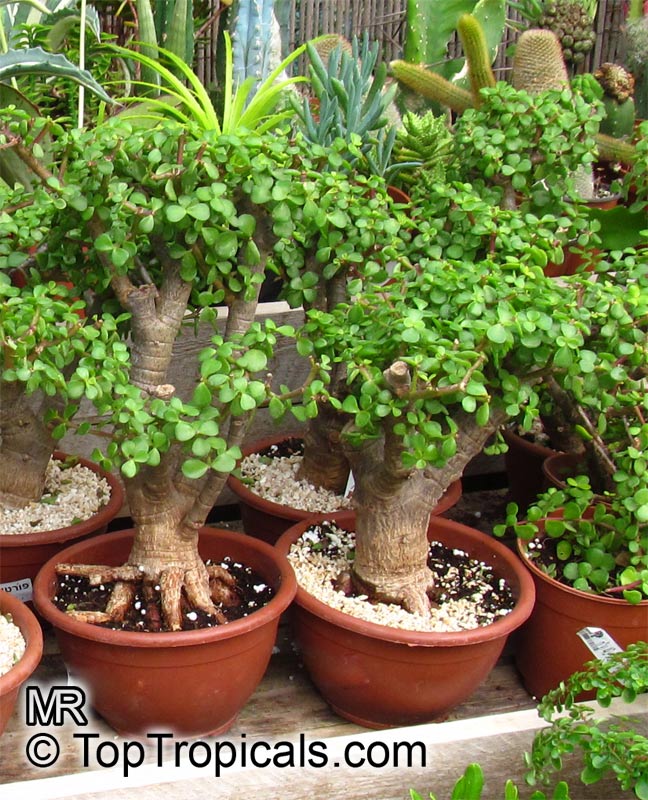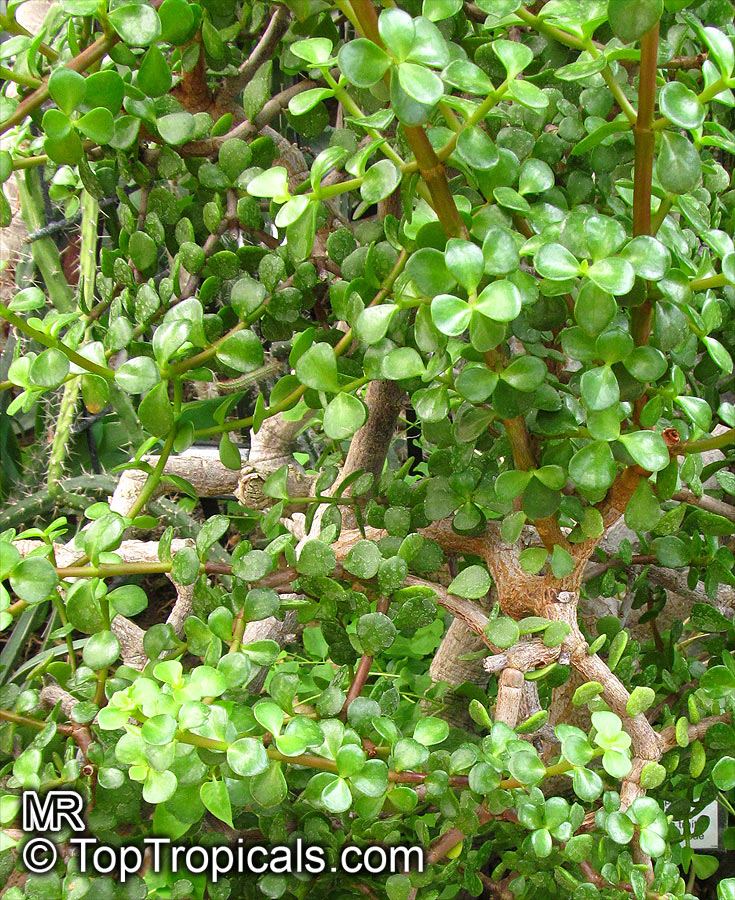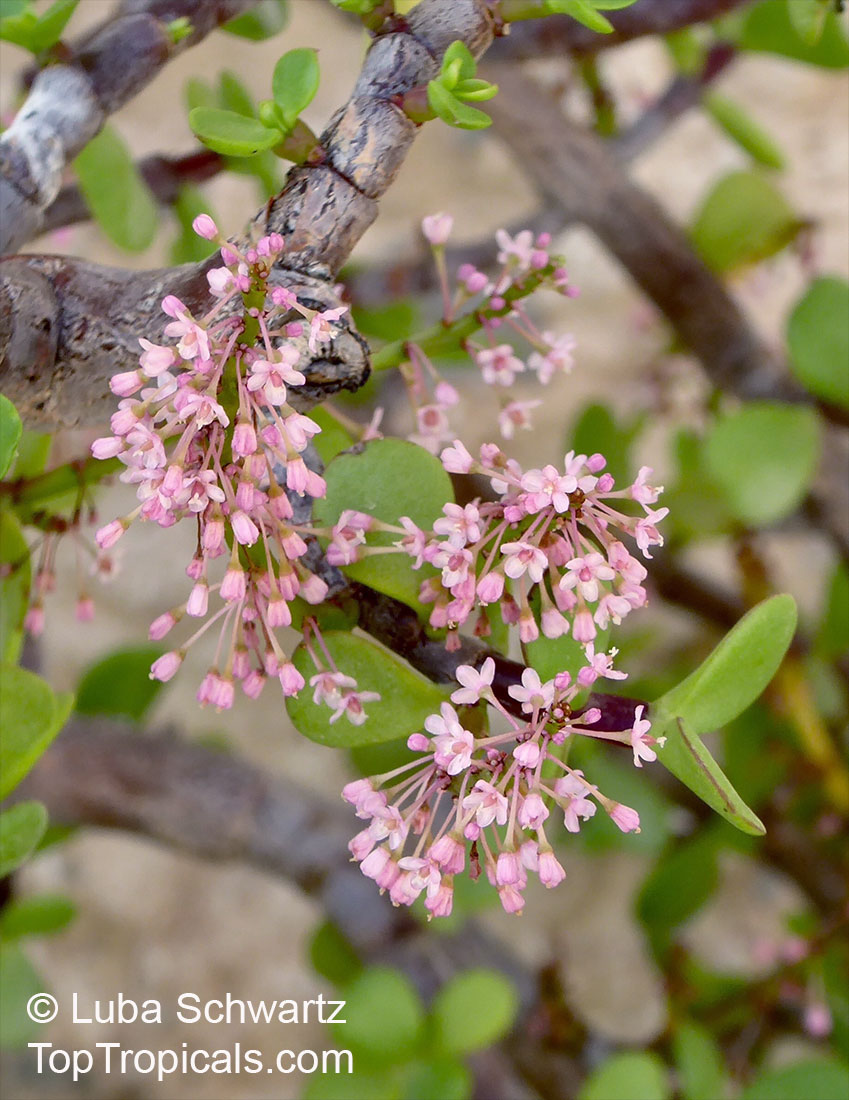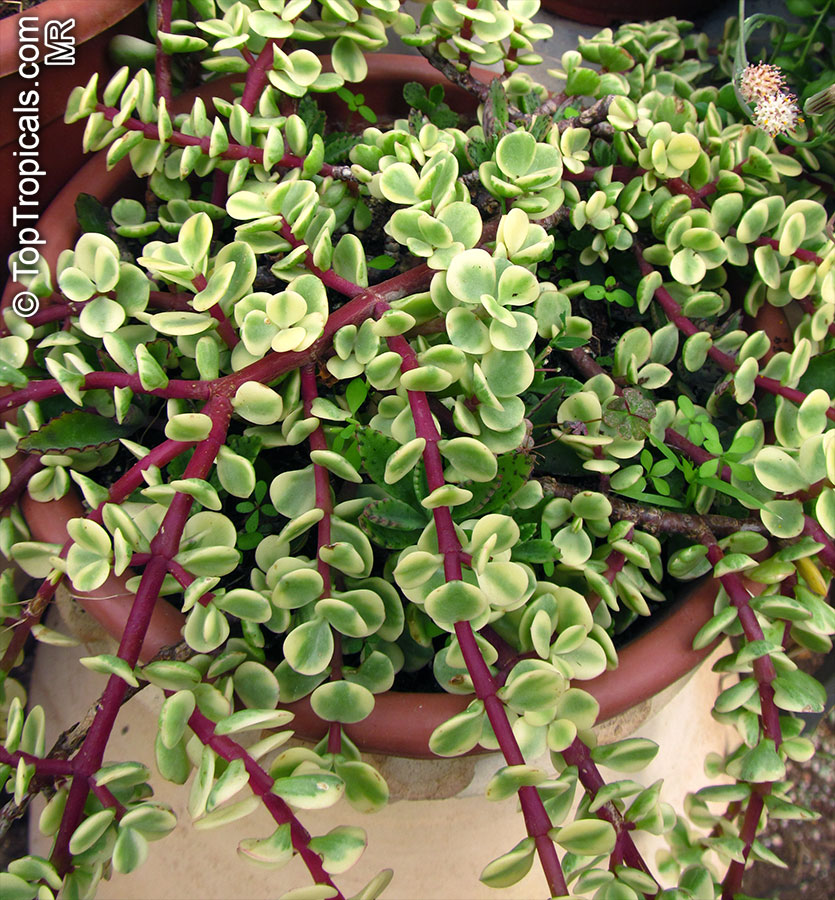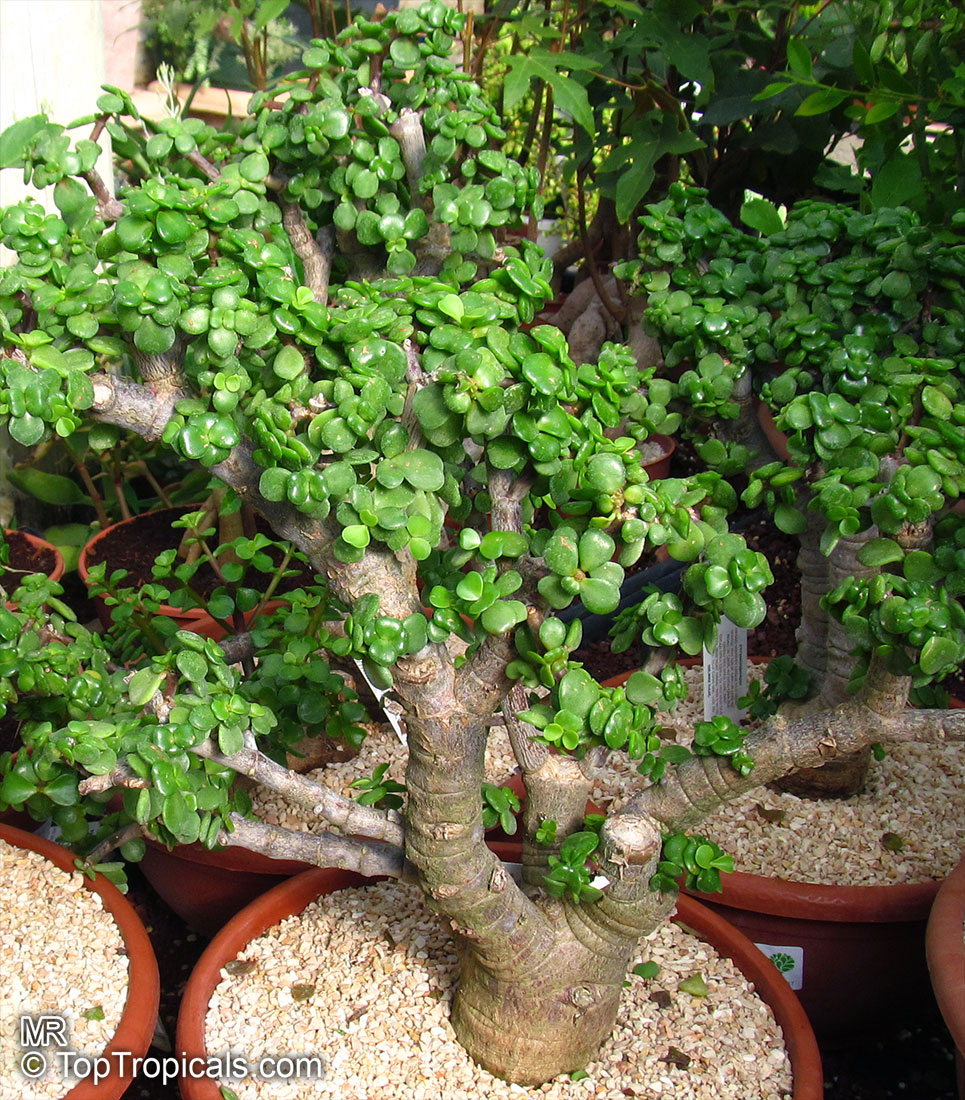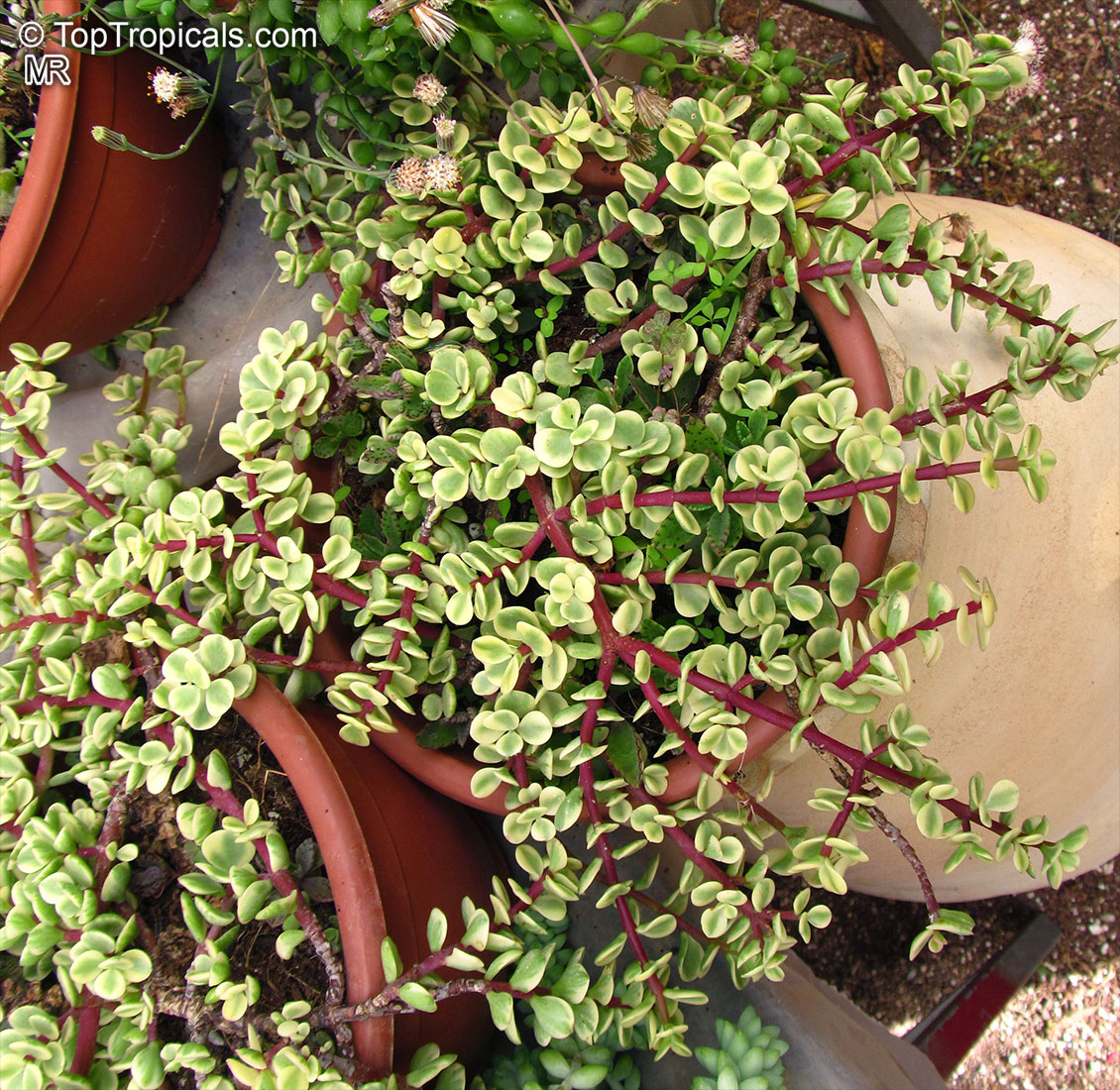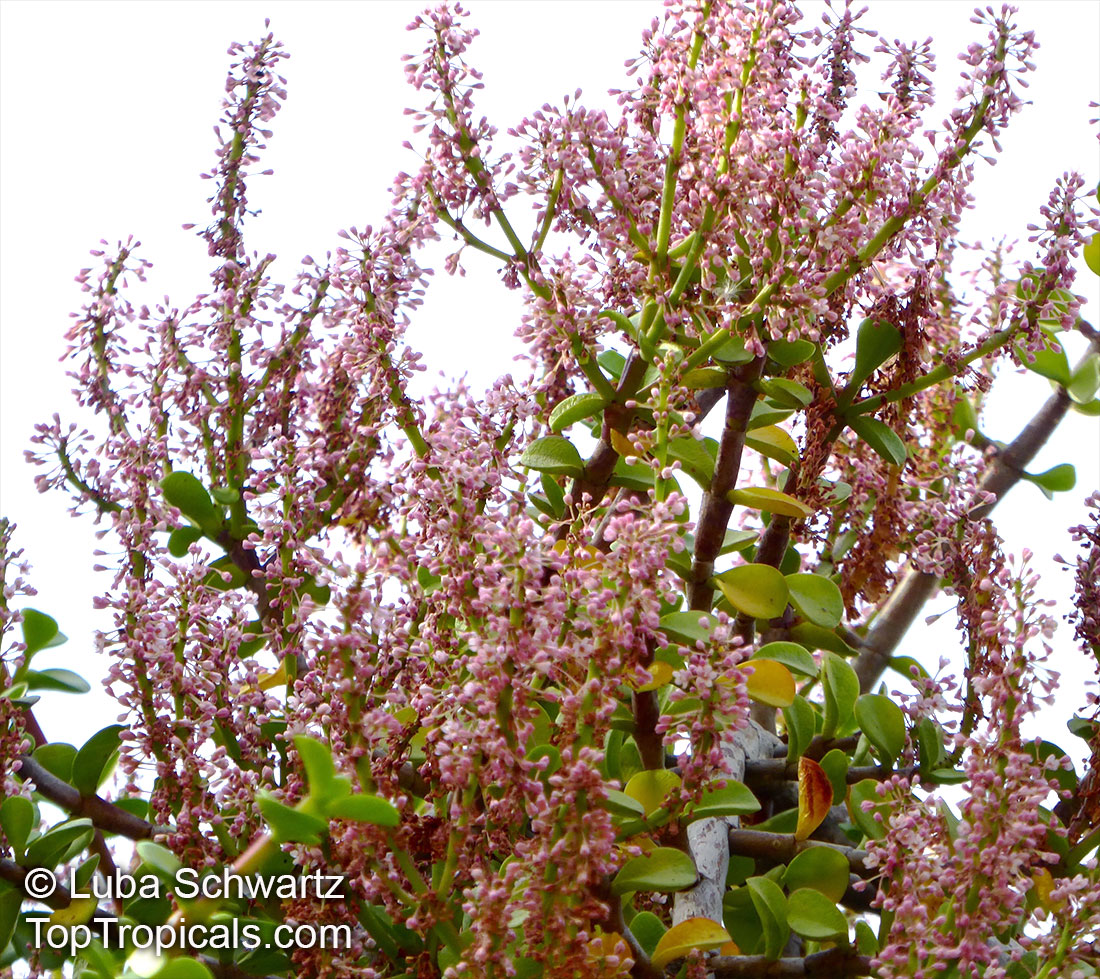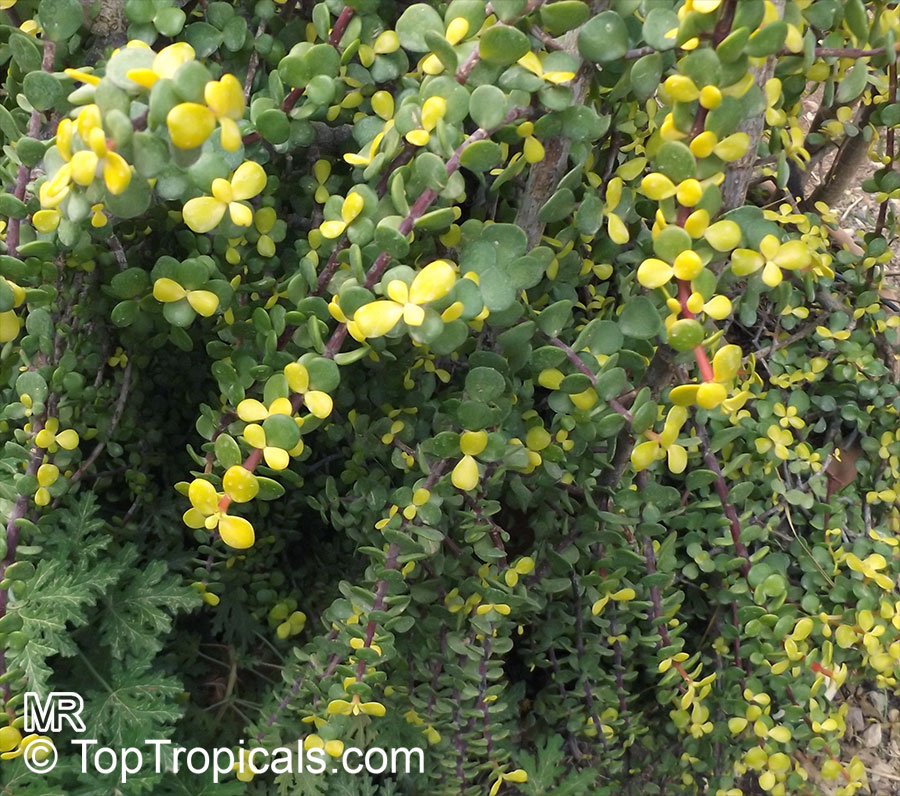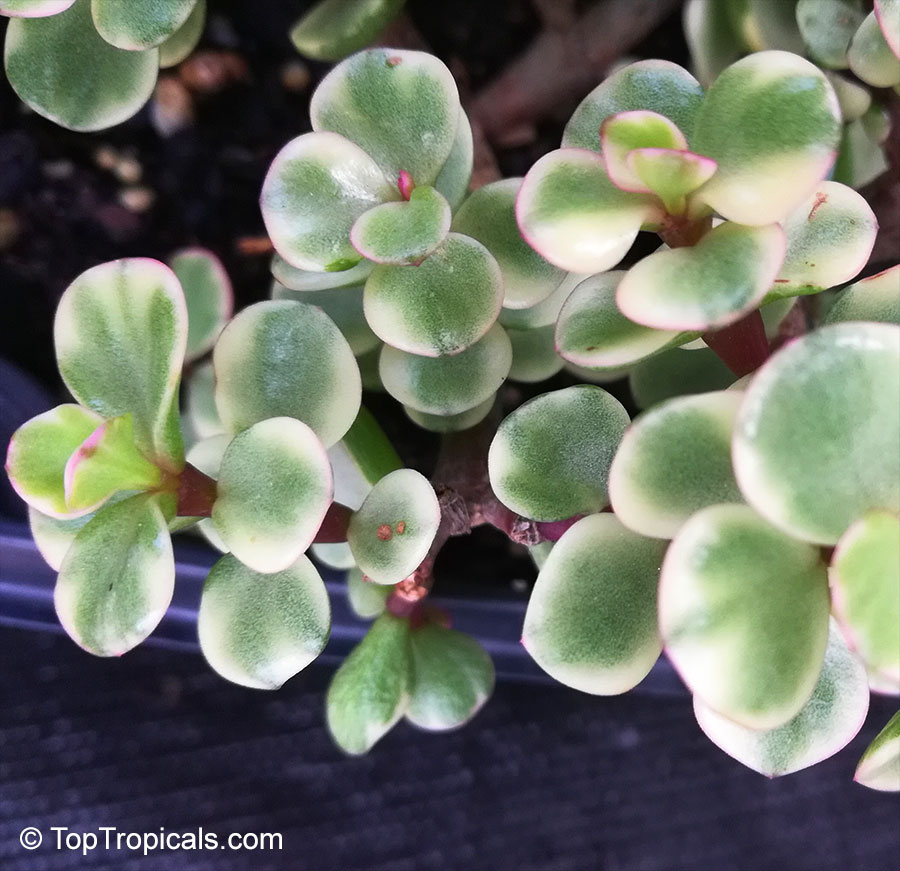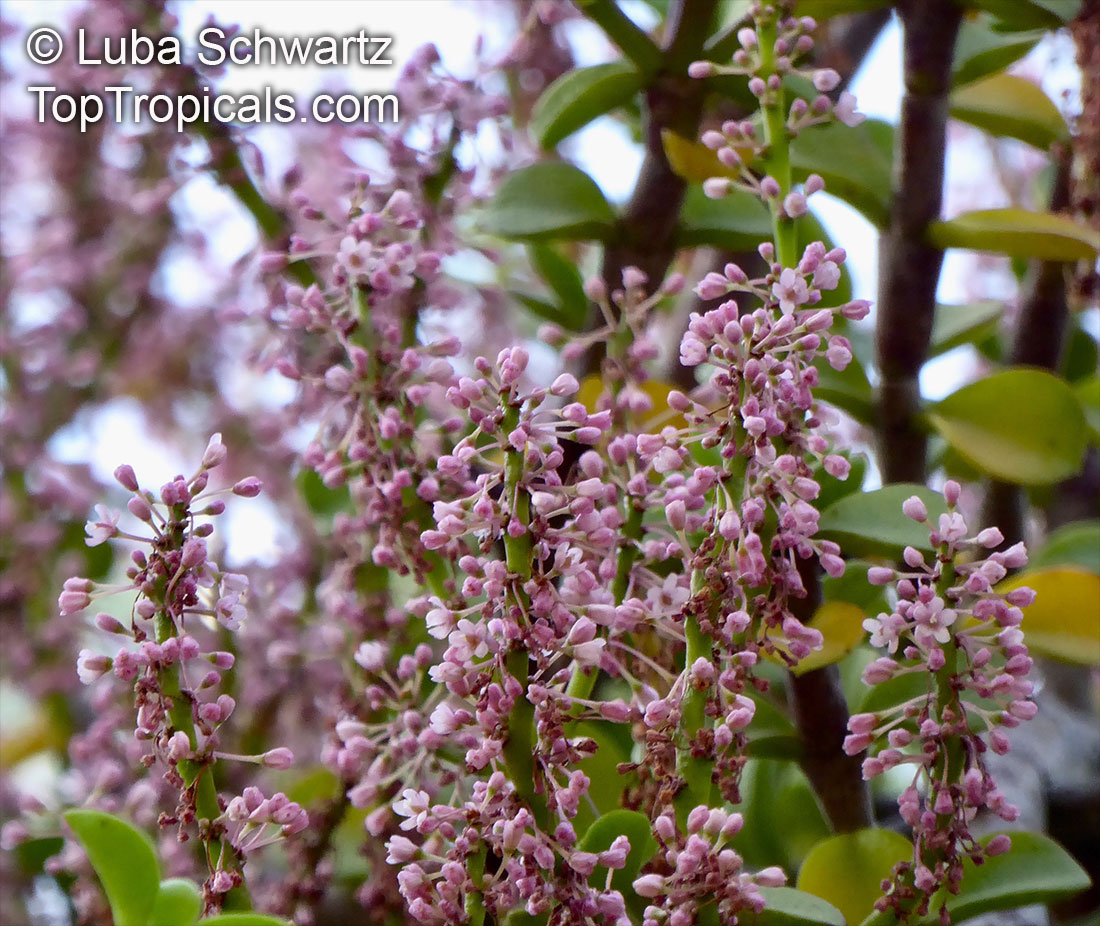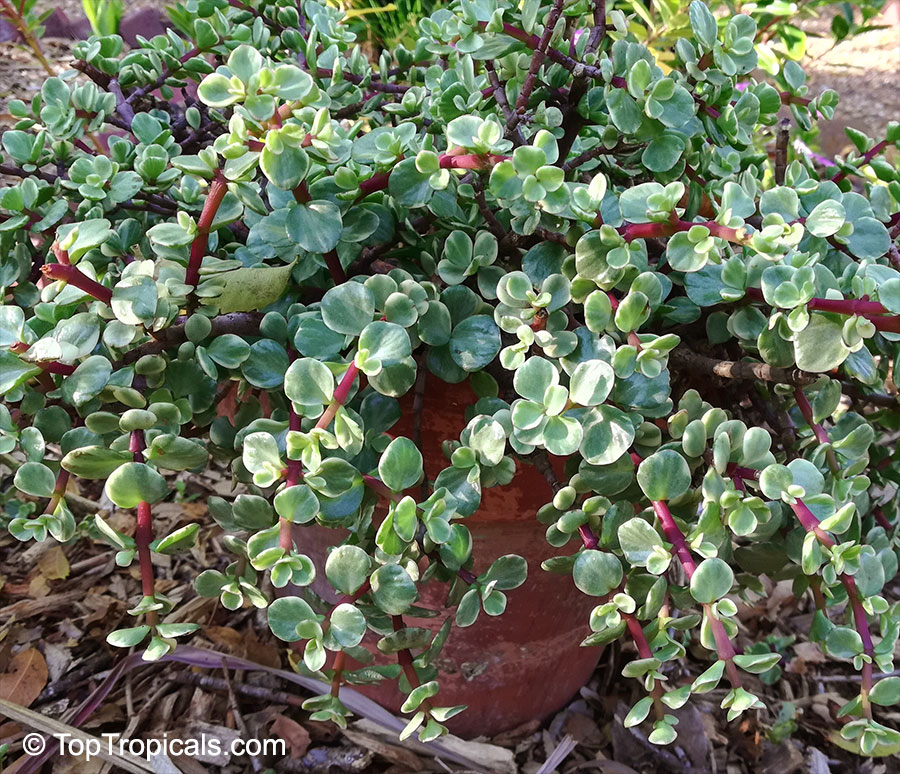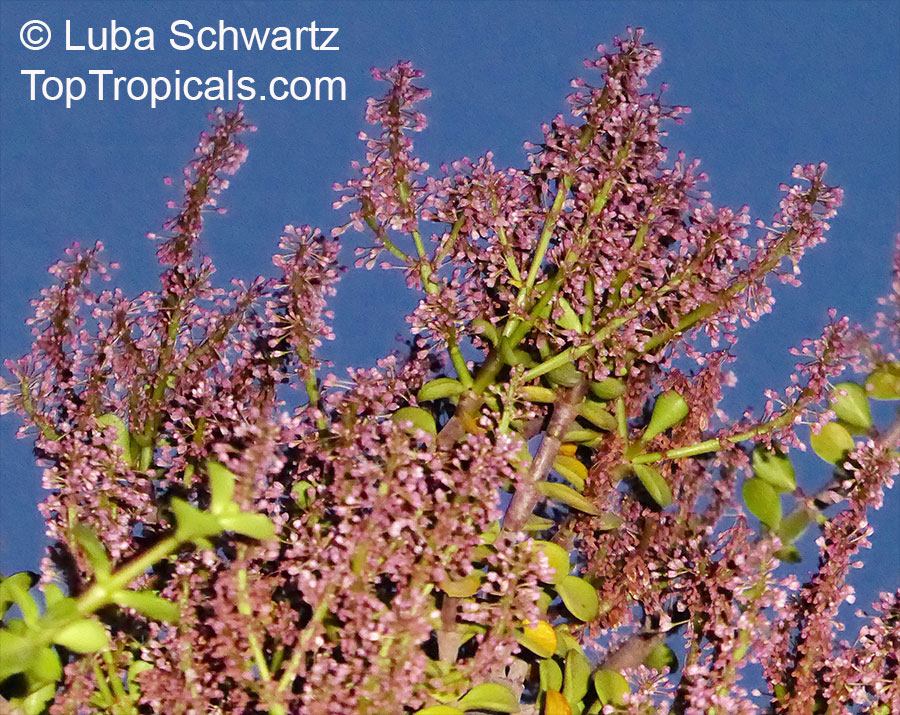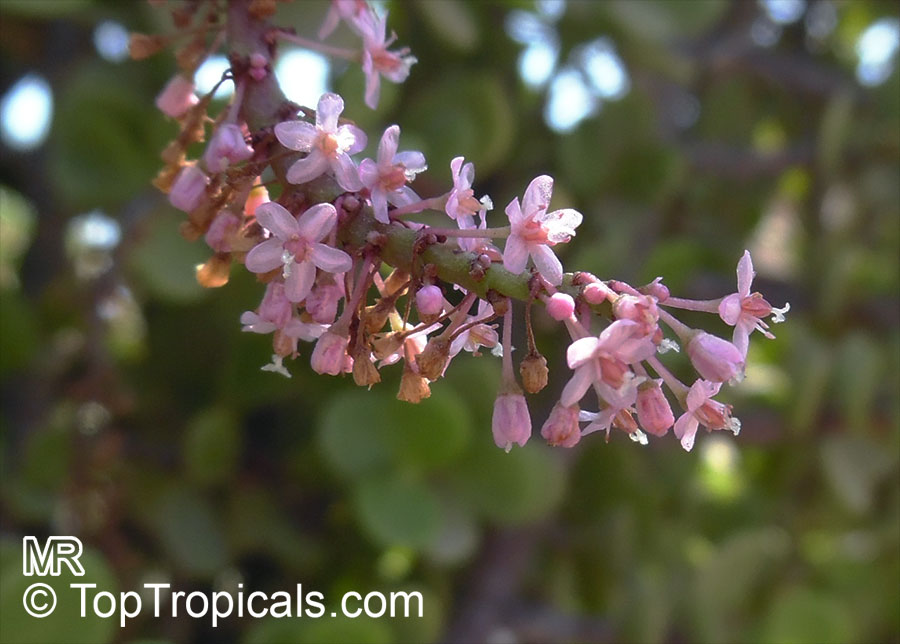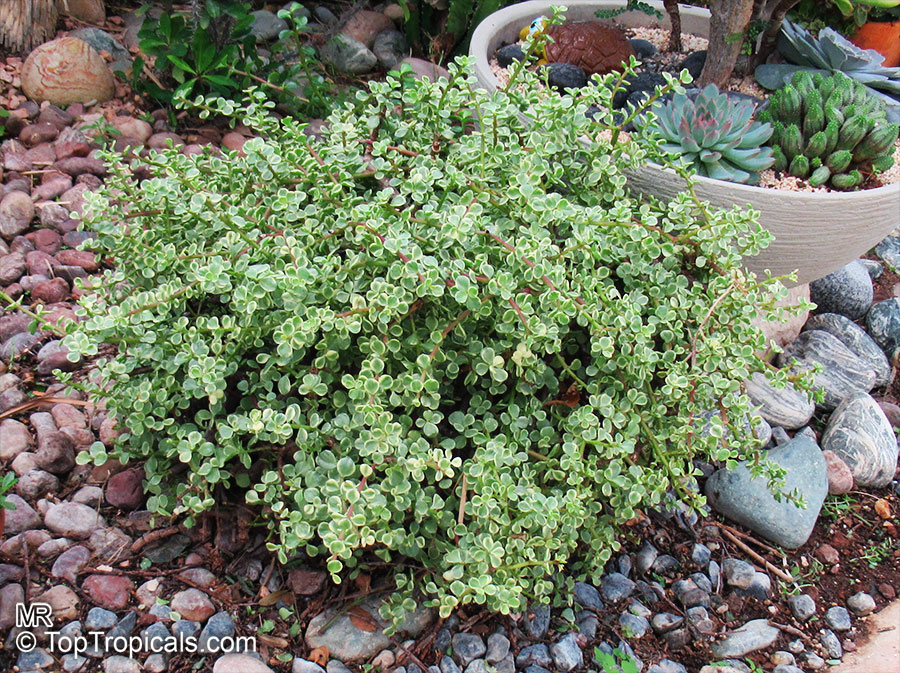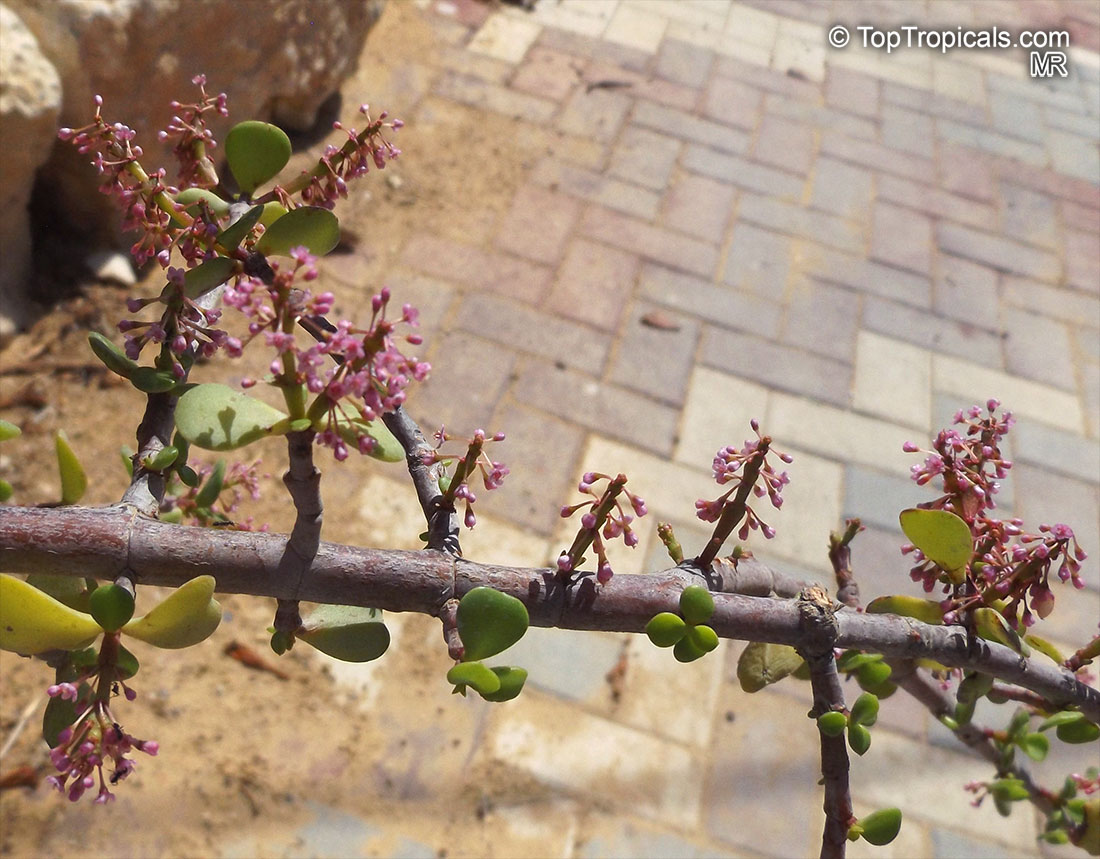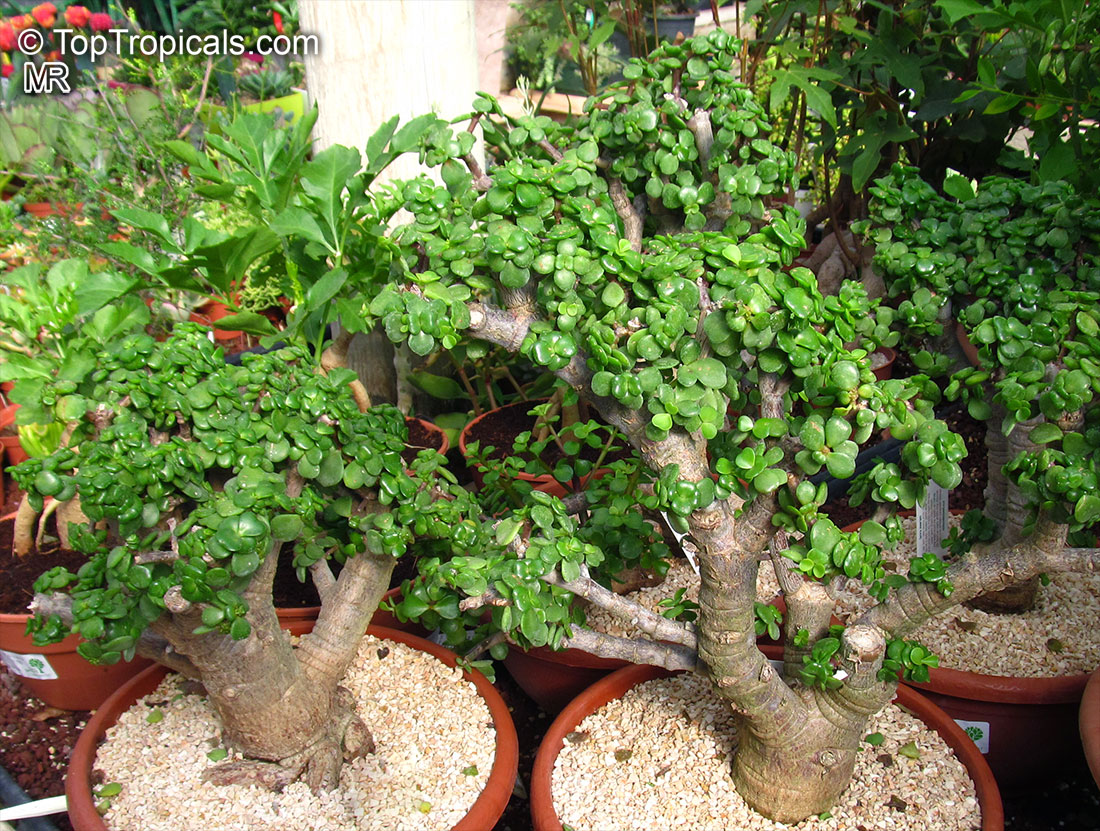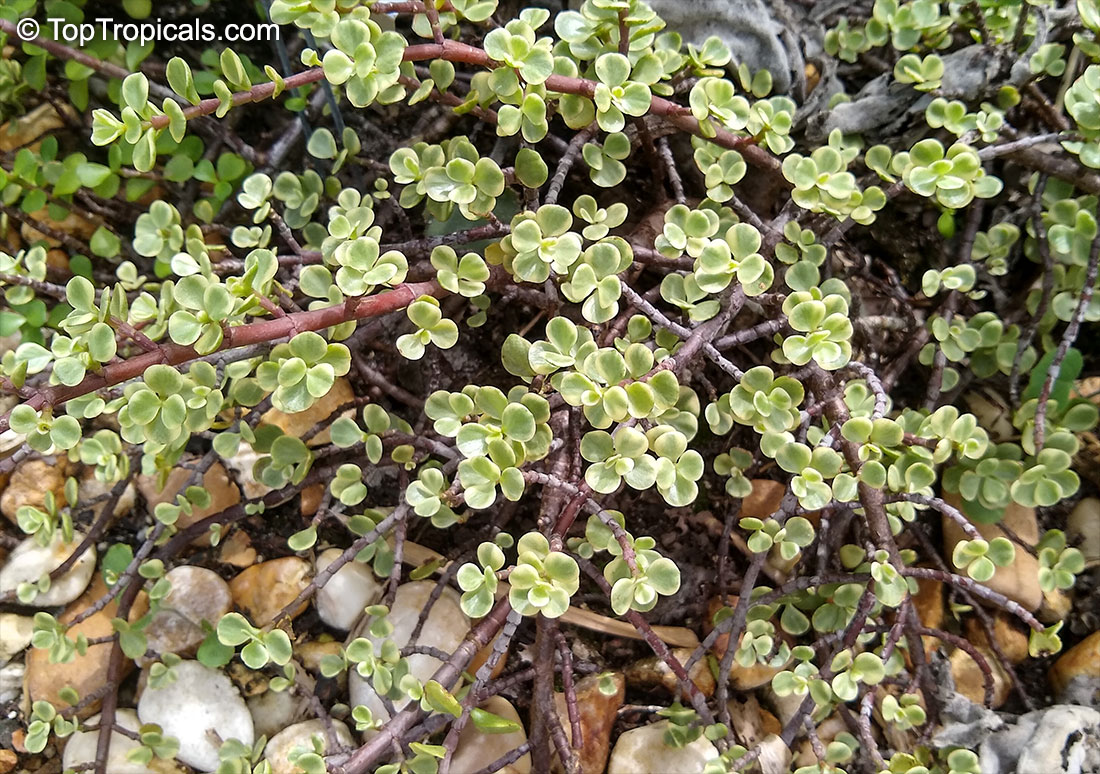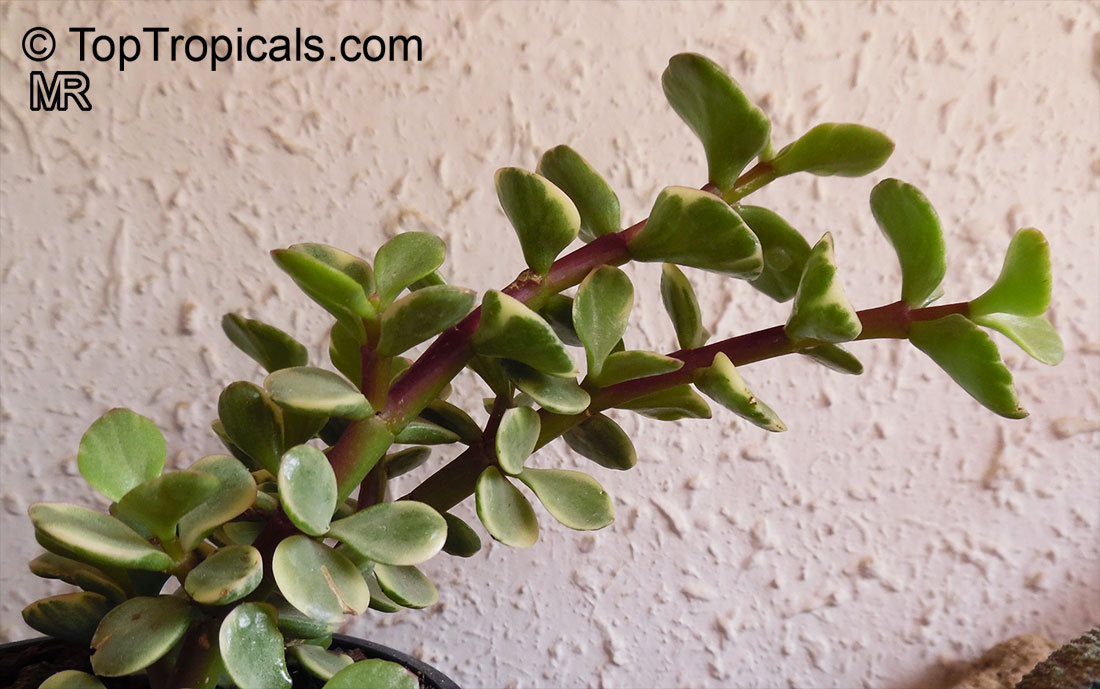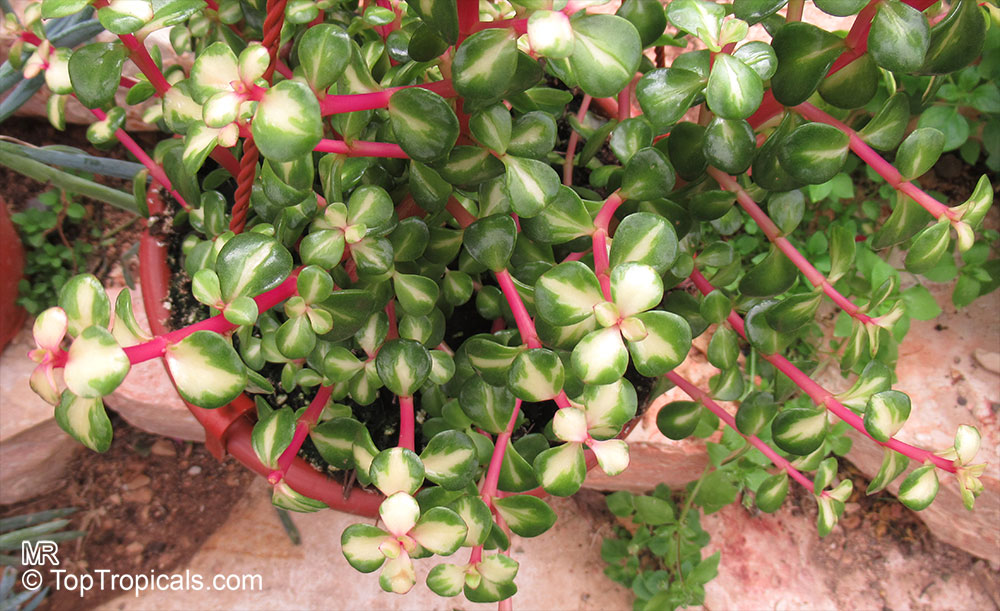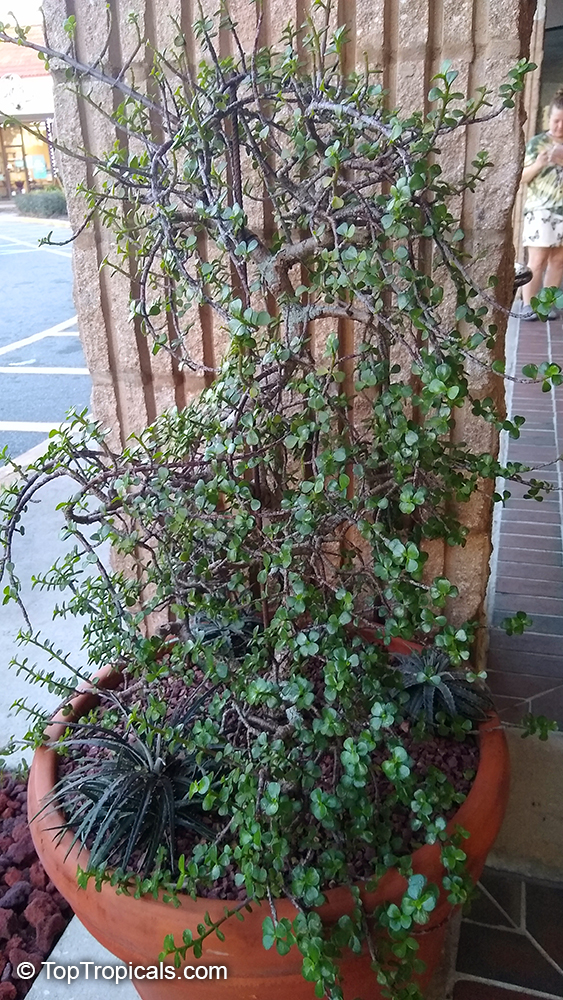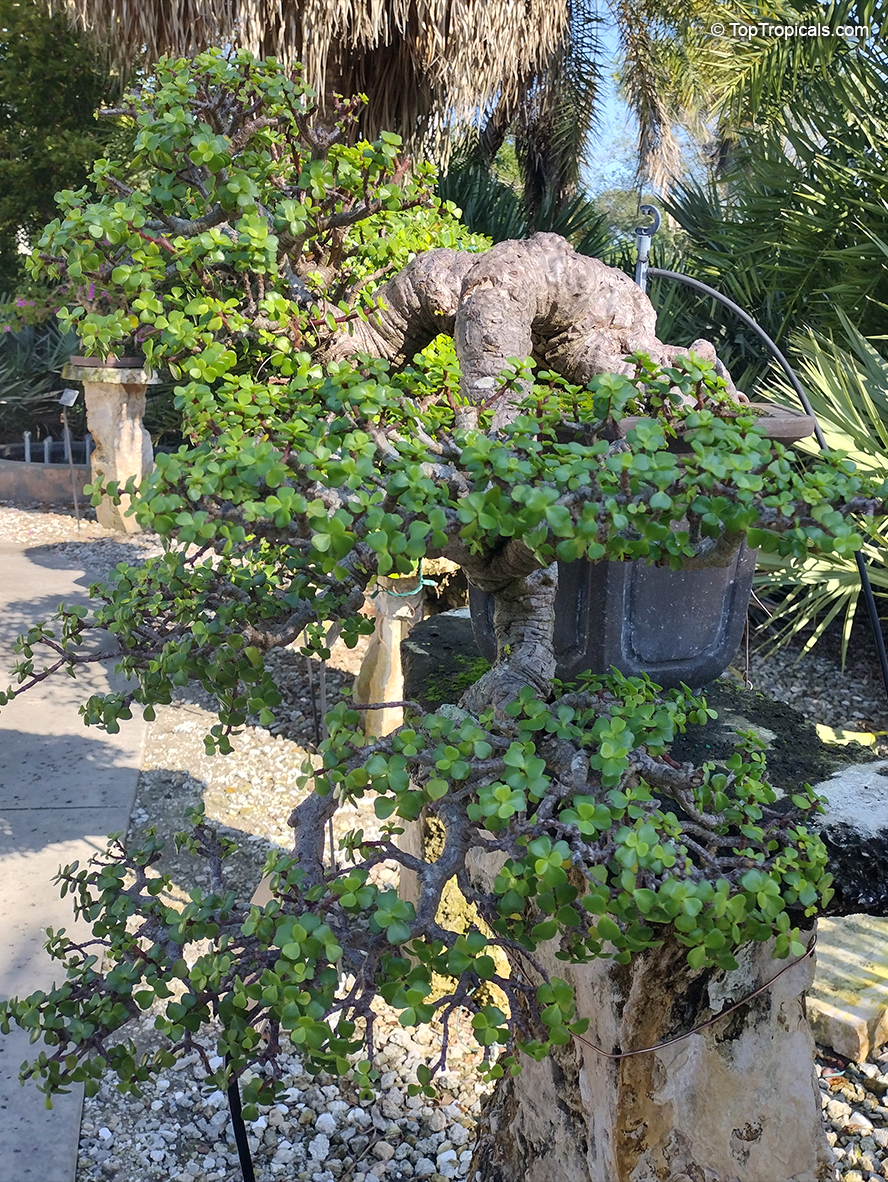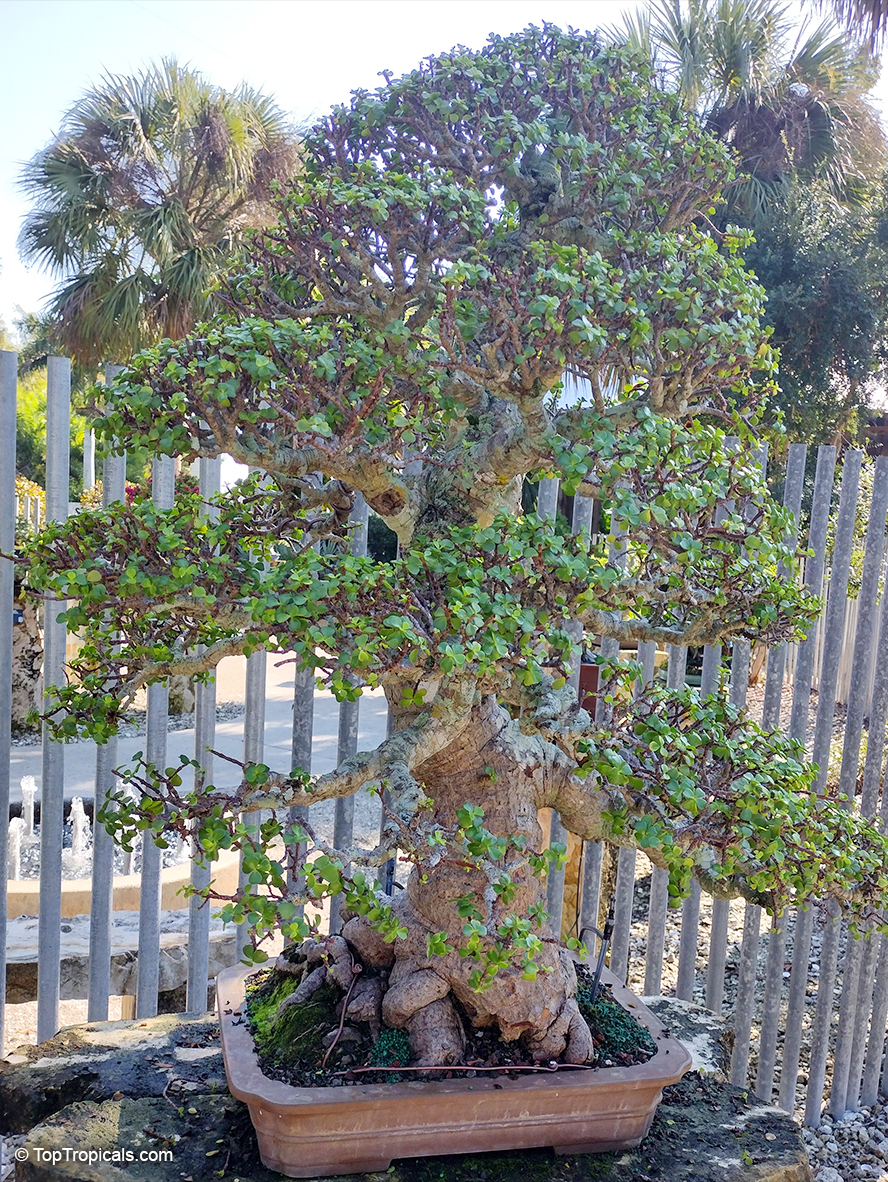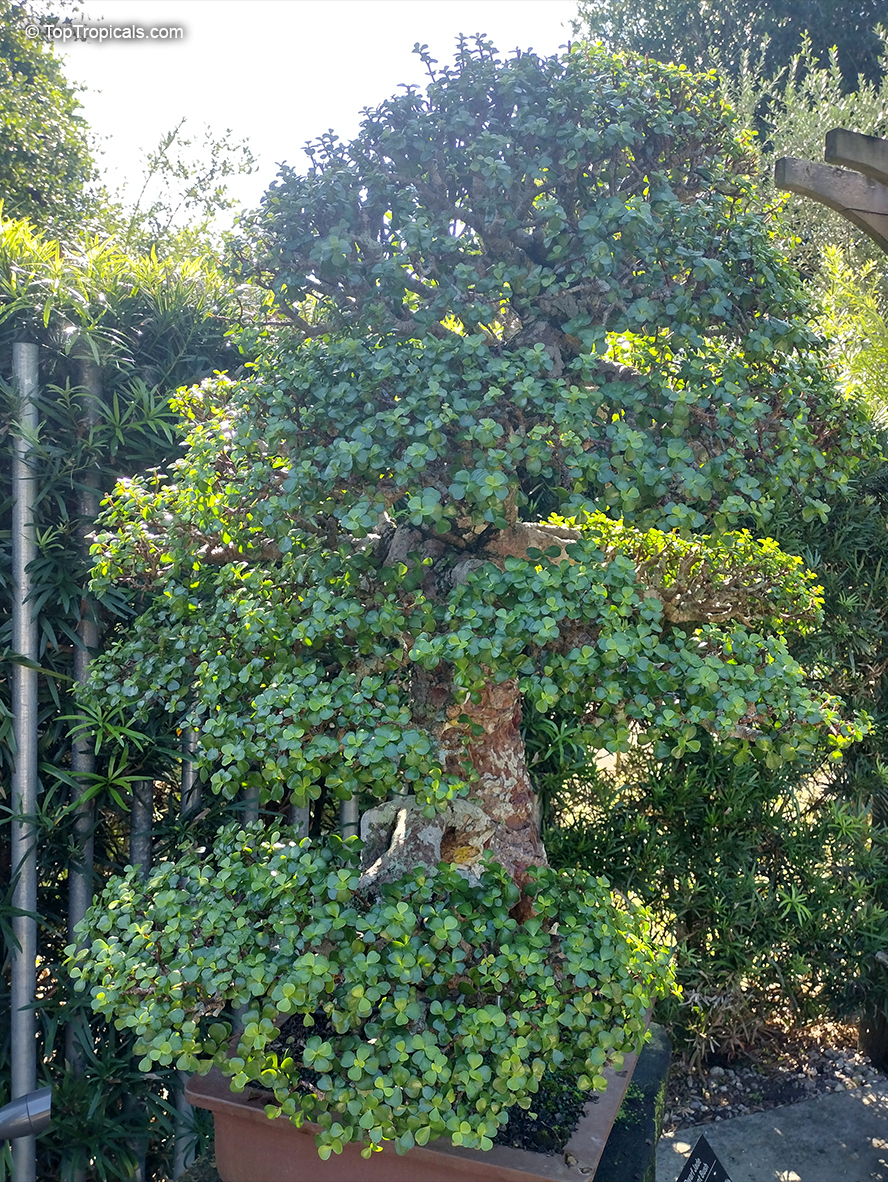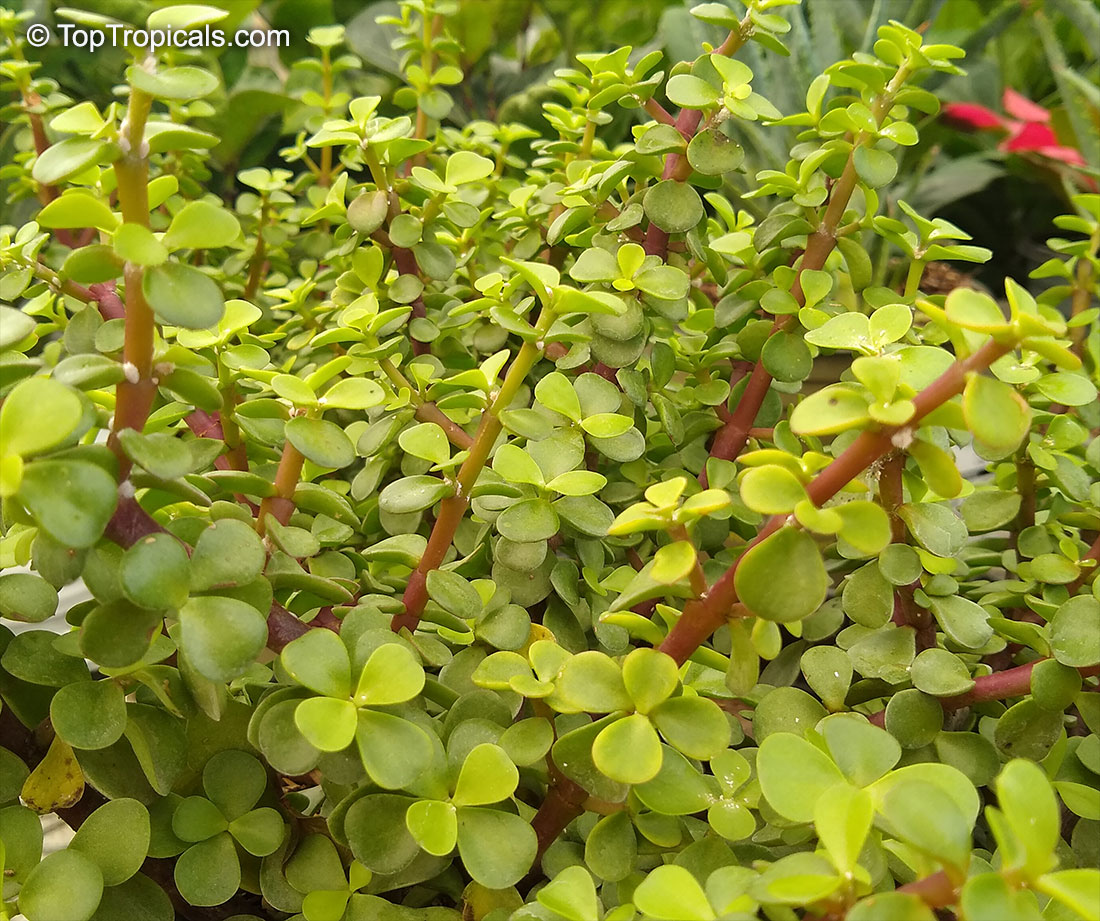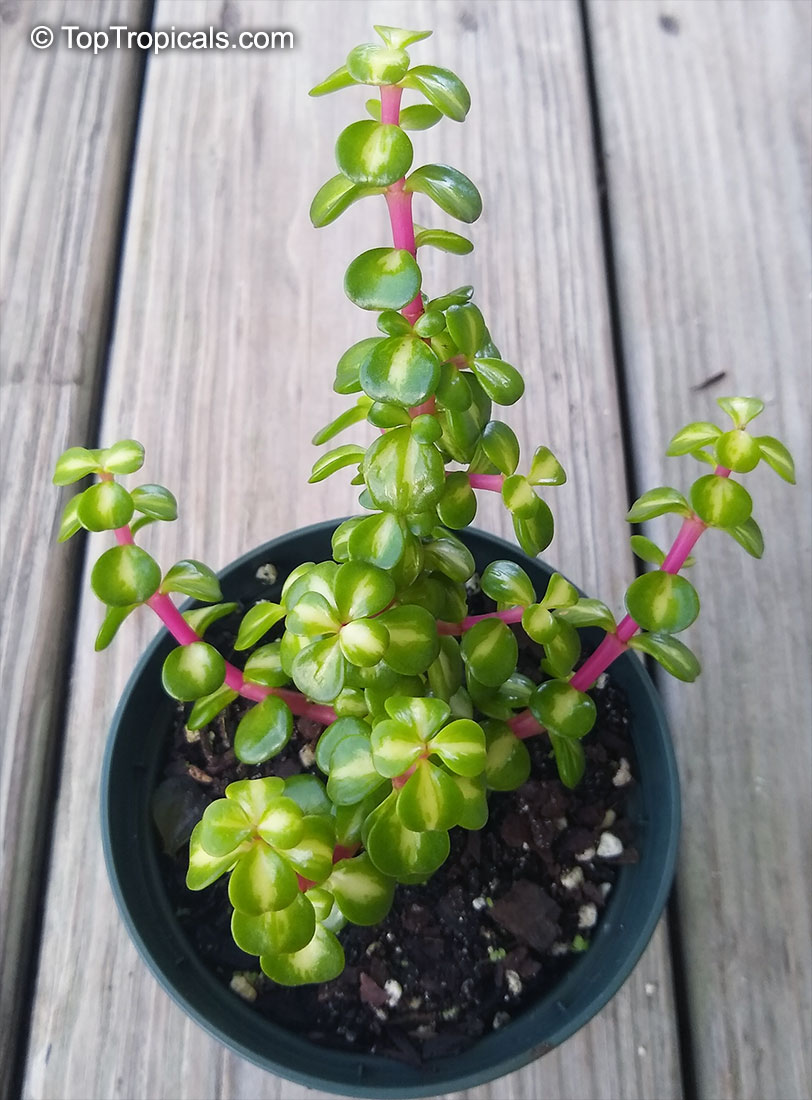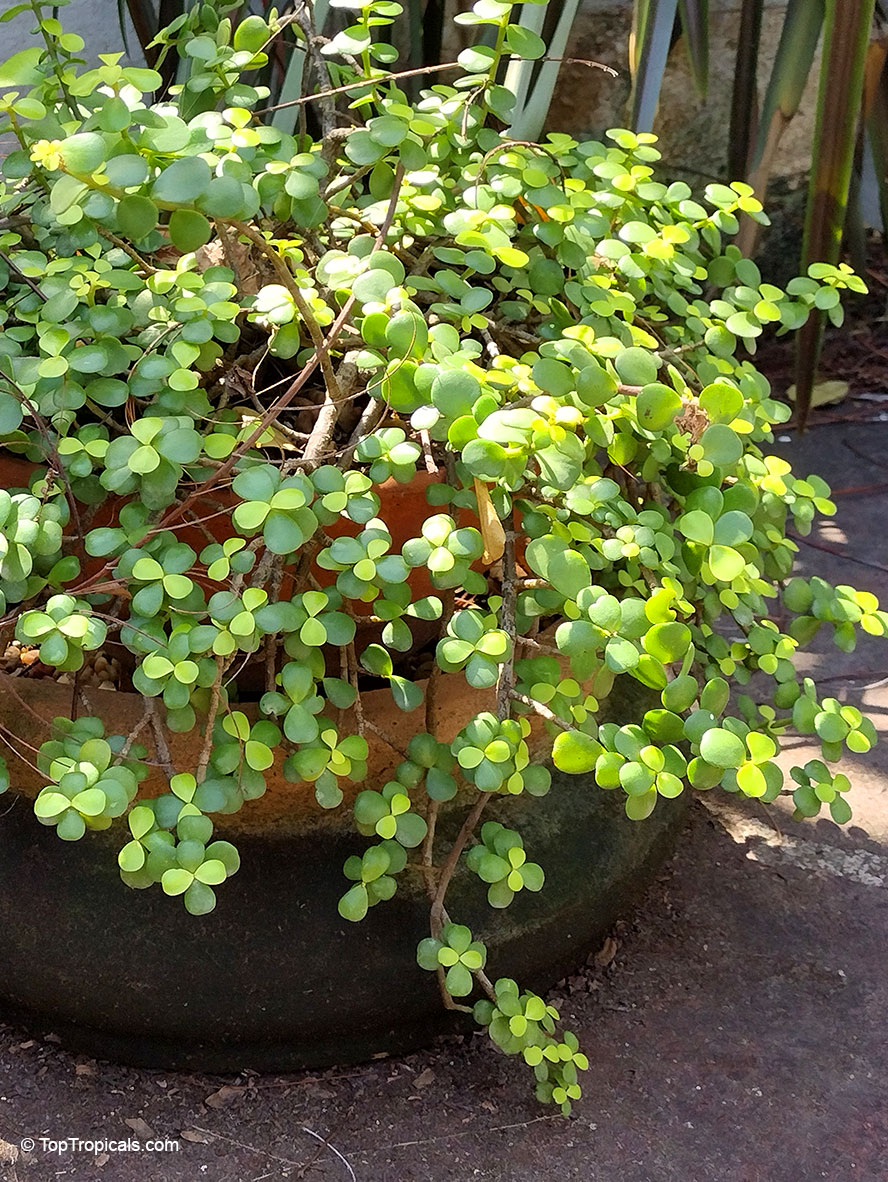Didiereaceae - Botanical Family
Top Tropicals Plant Encyclopedia
| Number of plants found: 8 |
Botanical name: Alluaudia comosa
Common name: Hairy Alluaudia
Family: Didiereaceae
Origin: Madagascar







Alluaudia is a genus of six species of flowering plants endemic to Madagascar. Several of the species are grown as indoor ornamental plants in specialist succulent collections. Drought-tolerant; suitable for xeriscaping
Suitable for growing in containers.
Botanical name: Alluaudia dumosa
Common name: Alluaudia
Family: Didiereaceae
Origin: Madagascar






Alluaudia dumosa is a beautiful, drought-tolerant large shrub or small tree native to Madagascar. It can grow up to 5-10 feet in height, with a wide spreading habit, and has thorns or spines that gives it a wild, exotic look. The tubular leafless branches are thick and white, with a fine gray powdery coating. The bark is gray and the flowers are white and fragrant.
Though Alluaudia dumosa can be grown in partial shade or semi-shade, it does best in a full sun position with adequate ventilation. It is moderately drought-tolerant and requires regular enough sunlight for attractive flowering. It needs regular watering when growing in warm climates but requires only moderate water in most other climates. It does best in USDA Zone 9-11.
For those living in colder areas, it is possible to grow this plant successfully in a pot. Make sure the pot is sufficiently large with adequate drainage. Potted Alluaudia dumosa should be watered only when the soil has dried out. It should be allowed to rest in winter and in cold conditions, but, if the root ball dries out, the plant should be reprimed with water to prevent damage. Place the plant in a light, warm location and in bright indirect light but avoid direct sun as this can cause scorching of the foliage. Keep the plant near a south or southeast facing window to get the most of the sun's rays during the day.
With proper care, Alluaudia dumosa will leave you with a beautiful, lush addition to your garden.
Botanical name: Alluaudia procera
Common names: Madagascar Ocotillo, African Ocotillo
Family: Didiereaceae
Origin: Madagascar





This deciduous small to medium-sized plant grows up to 10-20 feet tall and is native to Madagascar. Its trunk and branches are covered with spiny, stiff, closely-set leaves and often twisted. Its bark is dark brown and its leaves show an array of colors including green and grey-green. Its flowers, which appear in late spring and fade in late summer, are small and white in color.
Alluaudia procera is a drought tolerant tree and prefers moderate water, once a week during the summer and then decreasing frequency during cooler months. When watering, ensure good drainage so that the soil does not become waterlogged. This small tree is frost hardy and will survive a few degrees below freezing for a short period of time. It is best to plant this tree in USDA Zone 9-11.
To successfully grow Alluaudia procera, it needs full sun to semi-shade in hotter climates and prefers well drained soil that can retain moisture during dry weather. The plant requires less water during the winter and can survive in a pot or planter. For colder regions, it is best to keep the plant in a pot that can be moved to a warmer area during freezing temperatures.
Alluaudia procera is a stunning small tree that can be enjoyed in warmer climates or grown indoors as a houseplant. With a minimal amount of care, it will reward its owners with its unique twisted trunk and small white flowers.
Botanical name: Alluaudia sp.
Common name: Alluaudia
Family: Didiereaceae
Origin: Madagascar





It is a large shrub, 5 to 10 feet tall, with a dense crown of spiny or thorny branches. This plant can be used for bonsai and is suitable for USDA Zones 9-11, where it usually requires little maintenance, moderate water, and regular trimming.
In cold regions, Alluaudia sp. can be grown in a pot in a warm location which provides either full sun or bright light. Provide minimal water during the winter months and don't allow the soil to become completely dry. If the temperature drops too low, the plant can experience frost damage, so keep it in a location where it is rarely exposed to temperatures below 40 degrees Fahrenheit.
To keep Alluaudia looking healthy, prune the branches to control size and shape. To encourage a denser, more compact crown, prune the bush back anytime from early spring to midsummer, cutting each of the stems to just above a set of strong leaves. Do any larger pruning in the fall when the protective spines are at their smallest. This shrub can also become infested with pests, like aphids and mealybugs, so inspect it regularly, and intervene with proper treatments if needed.
Overall, Alluaudia is a low-maintenance plant which is relatively easy to care for. With the right conditions and regular pruning, it can make for a beautiful and interesting addition to any garden, or even a bonsai collection.
Botanical names: Ceraria namaquensis, Portulacaria namaquensis
Common names: Namaqualand Ceraria, False Portulacaria, Namaqua Porkbush
Family: Didiereaceae (Formerly:Portulacaceae)
Subfamily: Portulacarioideae
Origin: South Africa






Very slow growing smallish, woody stemmed desert shrub with many short, spiky semi-deciduous, succulent leaves. It is usually grown grafted on Portulacaria afra.
Botanical name: Didierea madagascariensis
Common name: Octopus Tree
Family: Didiereaceae
Origin: Madagascar





Didierea madagascariensis, commonly known as the Octopus Tree, is an evergreen species of plant native to Madagascar, boasting an unusual and unique appearance. Stressing its drought-resistant capacity, it is capable of survival and lending an ornamental touch to gardens, parks and other public spaces.
It is a large shrub, reaching up to 5-10 feet tall. Its branches are twisted in a spiny and throny cylindrical dome-shaped form, exuding a rugged, curious beauty. Though hugely indestructible and able to withstand the toughest of dry conditions and extremes, it requires well-draining soil and full sun to reach its fullest potential.
Although preferring more humid and tropical regions that allow it to thrive, it can also grow and persist in USDA Zones 9 and 11 albeit with a few more special treatments and plant care. During cooler and colder climates, it should be potted, allowing for regular care and nourishment preventing drought damage. In these pot-grown scenarios, it should be placed in a spot where it can bask fully in the sun and watered regularly, ensuring the soil beneath remains consistently moist, yet not soggy.
As budding Octopus Tree cultivators ourselves, we can vouch for the long-term rewards of growing it, that of instantly captivating landscaping and timber resources. Not matter the terrain - the Octopus Tree is an ideal choice for draught-resistant, low-maintenance plant care.
Botanical name: Didierea trollii
Common name: Octopus Plant
Family: Didiereaceae
Origin: Madagascar




The spiny, succulent stems initially grow along the ground, bearing small deciduous green leaves when in active growth.
Botanical name: Portulacaria afra
Common names: Elephant's Food, Elephant Bush, Baby Jade, Crassula Portulacaria
Family: Didiereaceae (Formerly:Portulacaceae)
Subfamily: Portulacarioideae
Origin: South Africa









This interesting plant can be used as an indoor bonsai where sunlight or strong artificial light is sufficiently available. The plant known to us as P. Afra was first illustrated from a rooted cutting in 1732 by Dr. Johann Jakob Dillenius, Oxford professor of botany, in his Hortus elthamensis. Not having flowered, it was understandably thought to be a species of Crassula. The common names derive from the succulent nature of the plant's leaves and stout trunk, and also from the observation that elephants will browse upon this. This is a stout juicy-stemmed, soft-wooded, semi-evergreen upright shrub or small tree, in the ground growing about 9 ft tall. The diameter of the trunk can be 9" or more. The leaves and young branches/branch tips are quite phototropic. Older branches, gray, shiny and up to 2" thick, will hang down or trail on the ground. Spreading outward, less frequently they will grow erect, especially at the center of the plant. Has opposite, obovate (egg-shaped), glabrous, very fleshy, blunt green leaves usually less than 1" long and without a distinct petiole or leaf stem. The flowers are white/pink/rose/lilac-colored. In South Africa P. afra bears these star-shaped flowers in late spring and summer after the rains, but seldom blooms in the western U.S., Hawaii, or Florida. The flowers are rare in cultivation, but if kept very dry the older and presumably unpruned plants may flower after rain. The berry-like fruit is pinkish, small, light, dry, transparent. Leaves of plants grown in full sun are smaller than those of the same variety grown in partial shade. Full sun is also known to bleach the leaves to a pale yellowish color on some large potted specimens. Brown patches on leaves can be due to sun scorch. Move the affected plant to a more airy place and shade from the hot sun for two weeks. Cuttings can become rooted in water, but after about one month the cutting needs to be put in soil or else it will rot.
In Africa, it is a favorite food for both Elephants and Rhinoceros, and is grown in farms for feeding both animals and people. The foliage when eaten raw, steamed, lightly boiled, or especially stir-fried, is not only delicious but actually very nutritious, containing more beneficial Beta 3 fatty acids than most fish.
Read more about Portulacaria afra.
Use link to repeat this search:
https://toptropicals.com/cgi-bin/garden_catalog/cat.cgi?search_op=and&keyword_op=and&language=e&family=Didiereaceae
&number=10&no_change_lang=1&user=tt&sale=1&first=0
